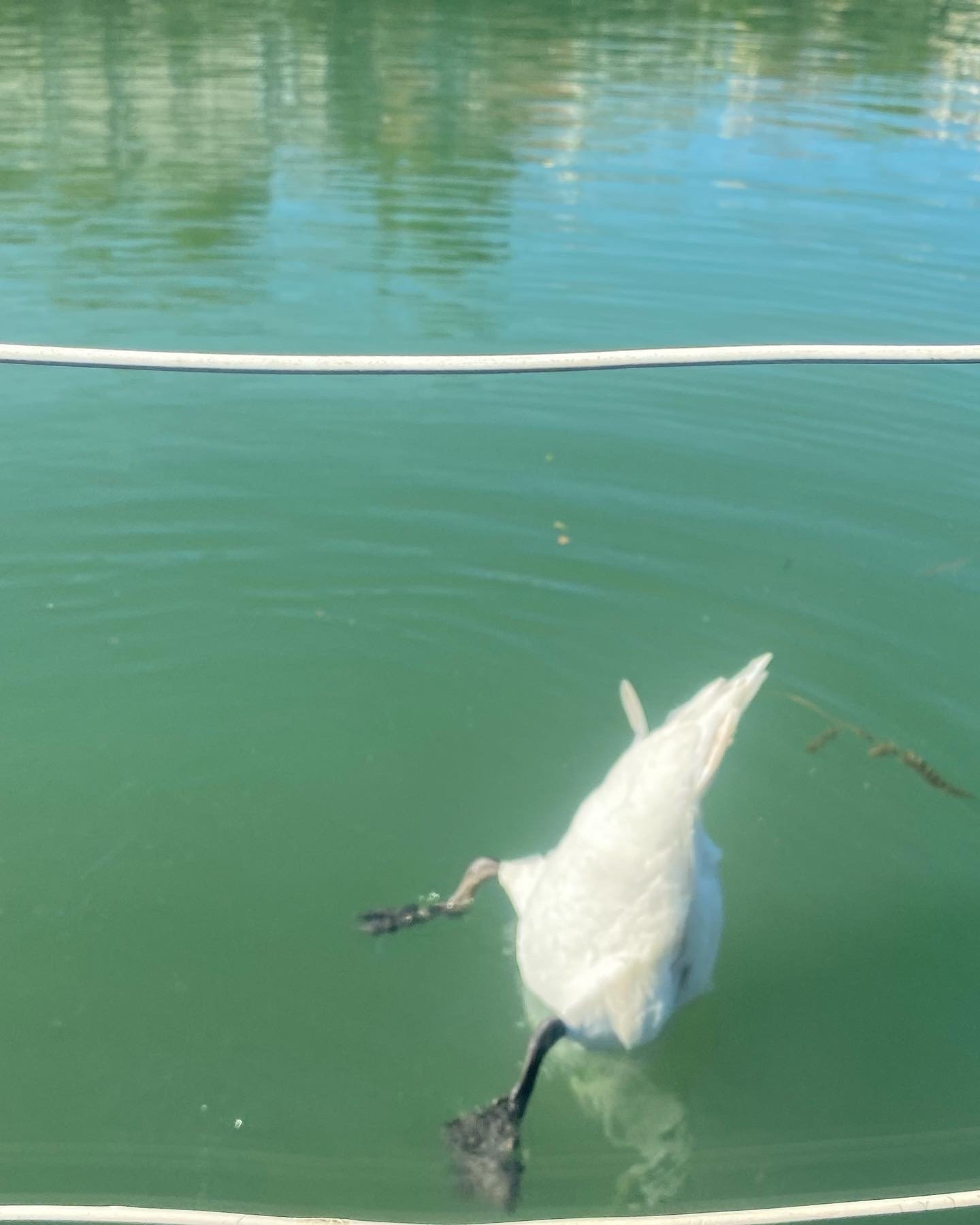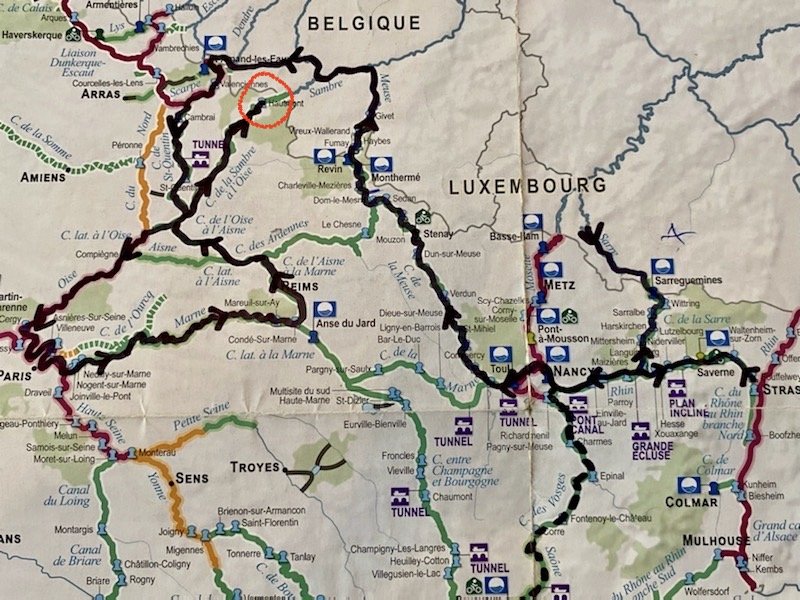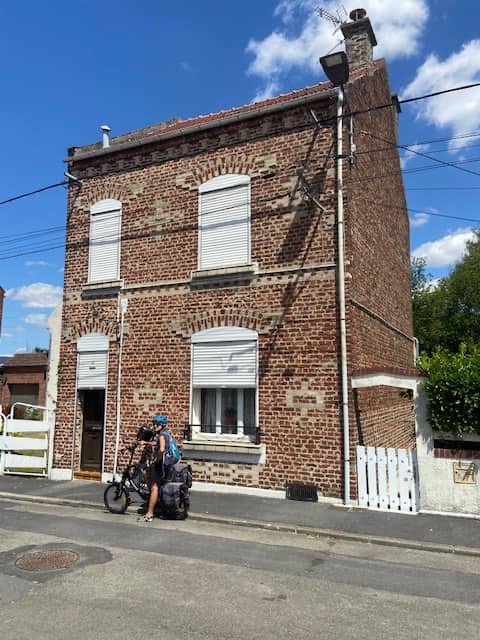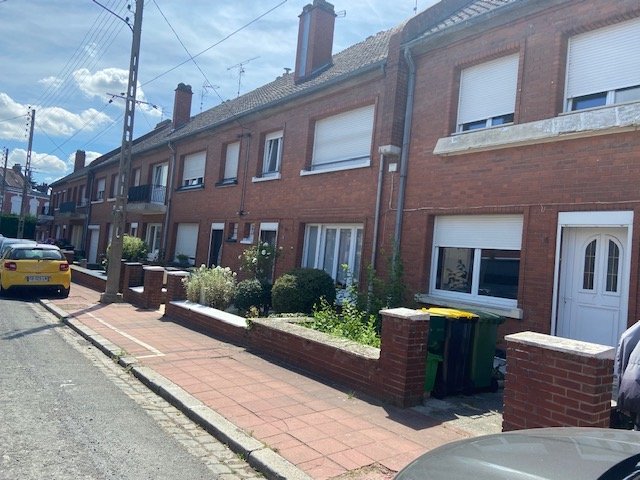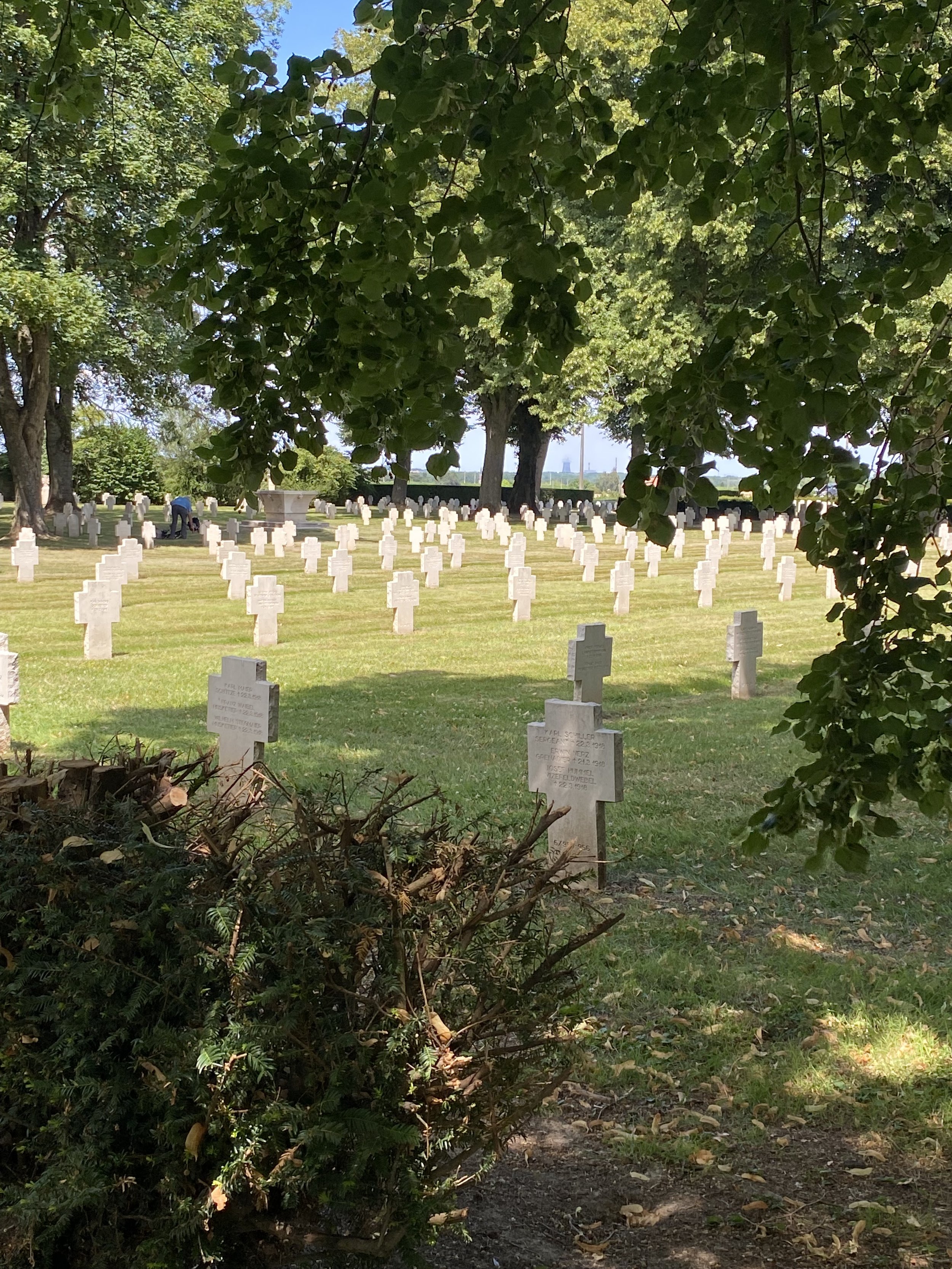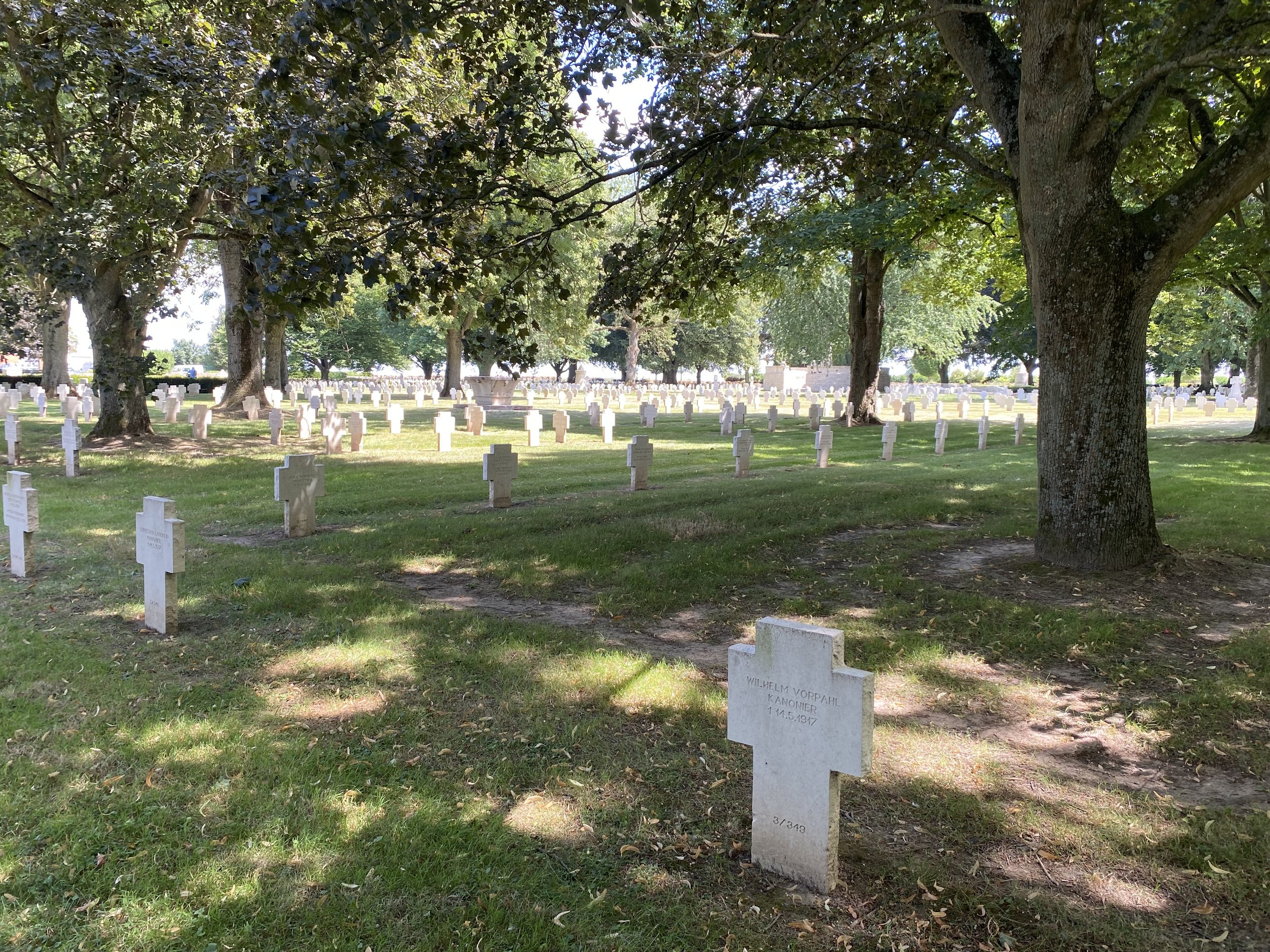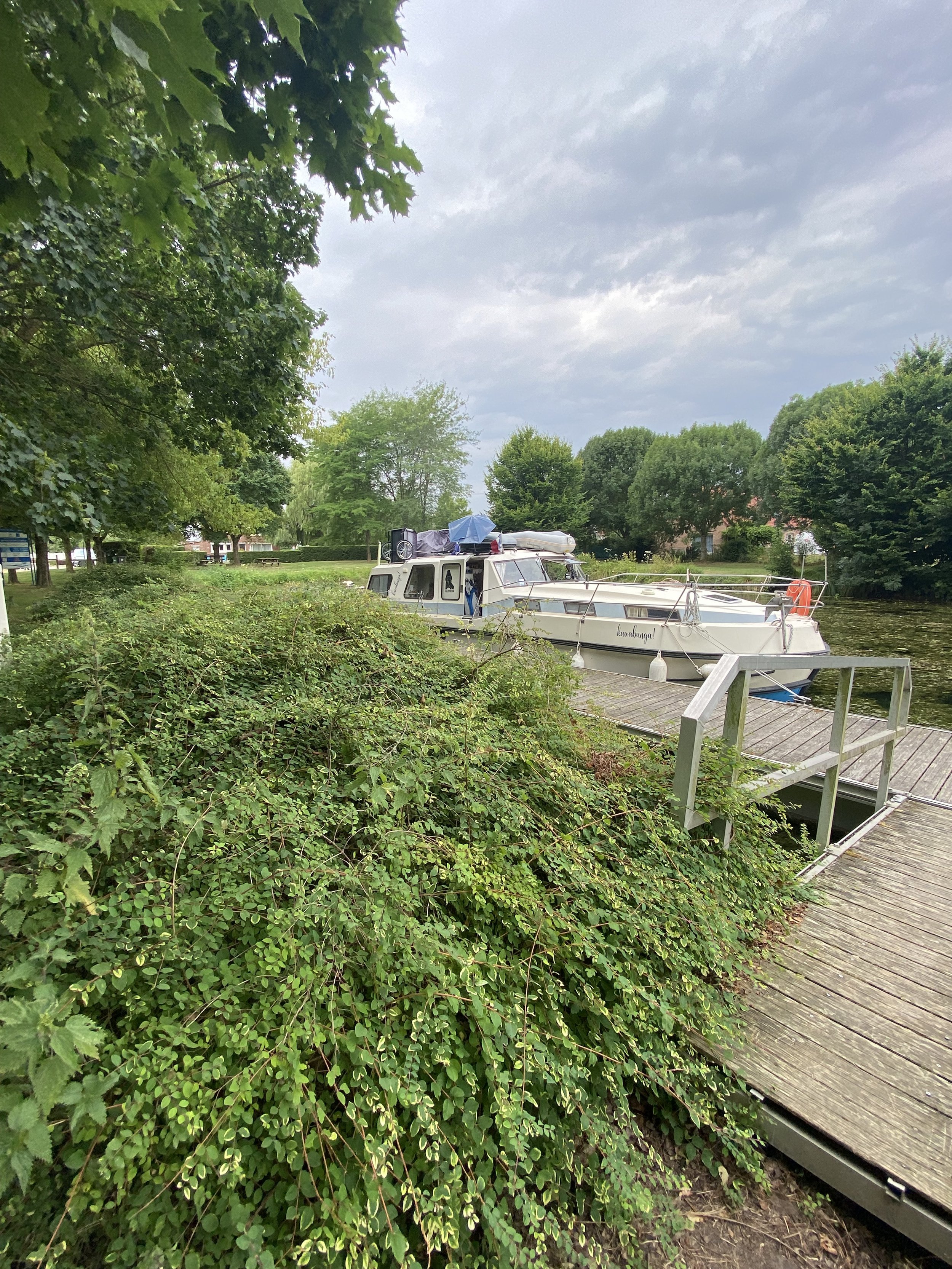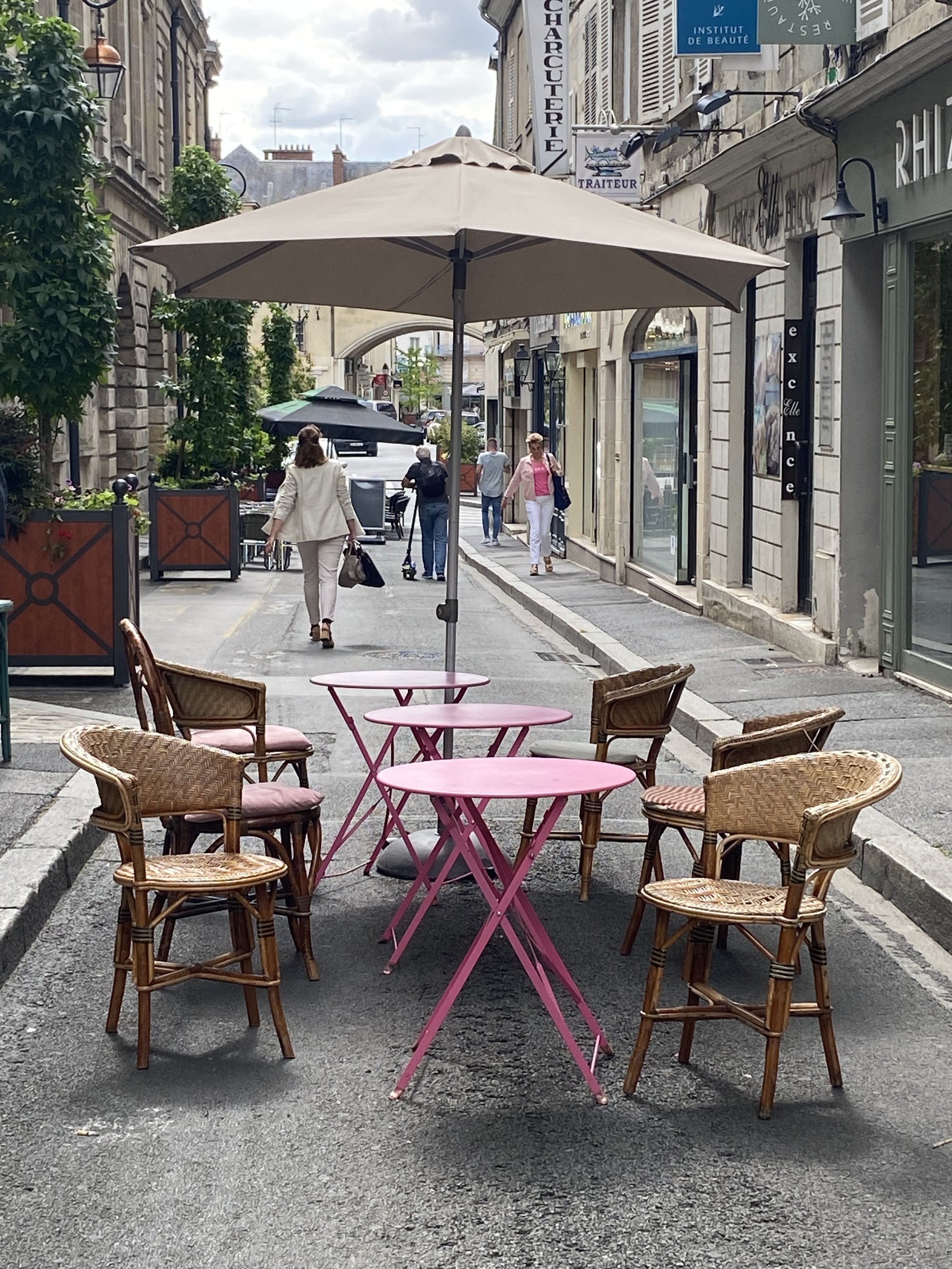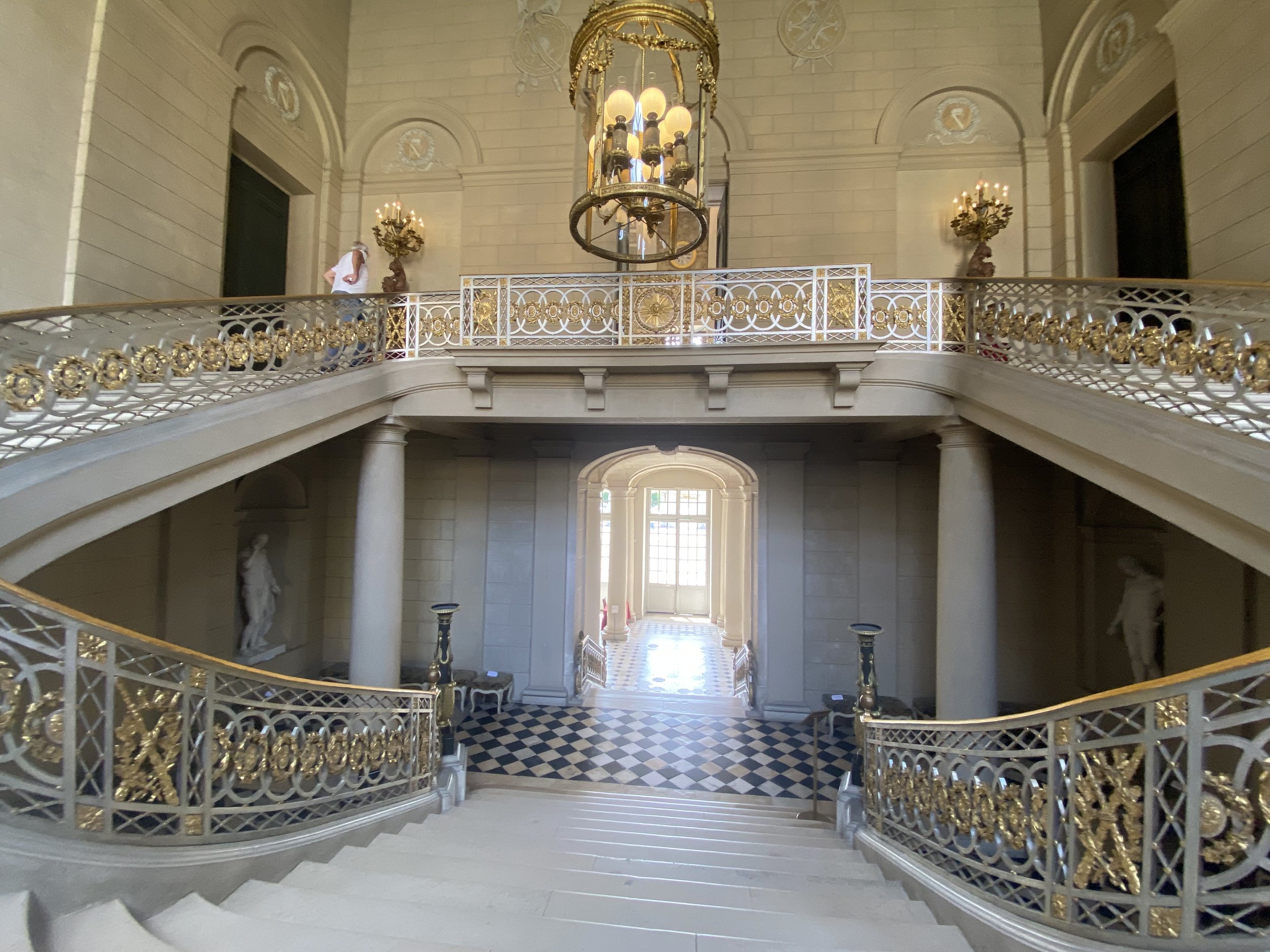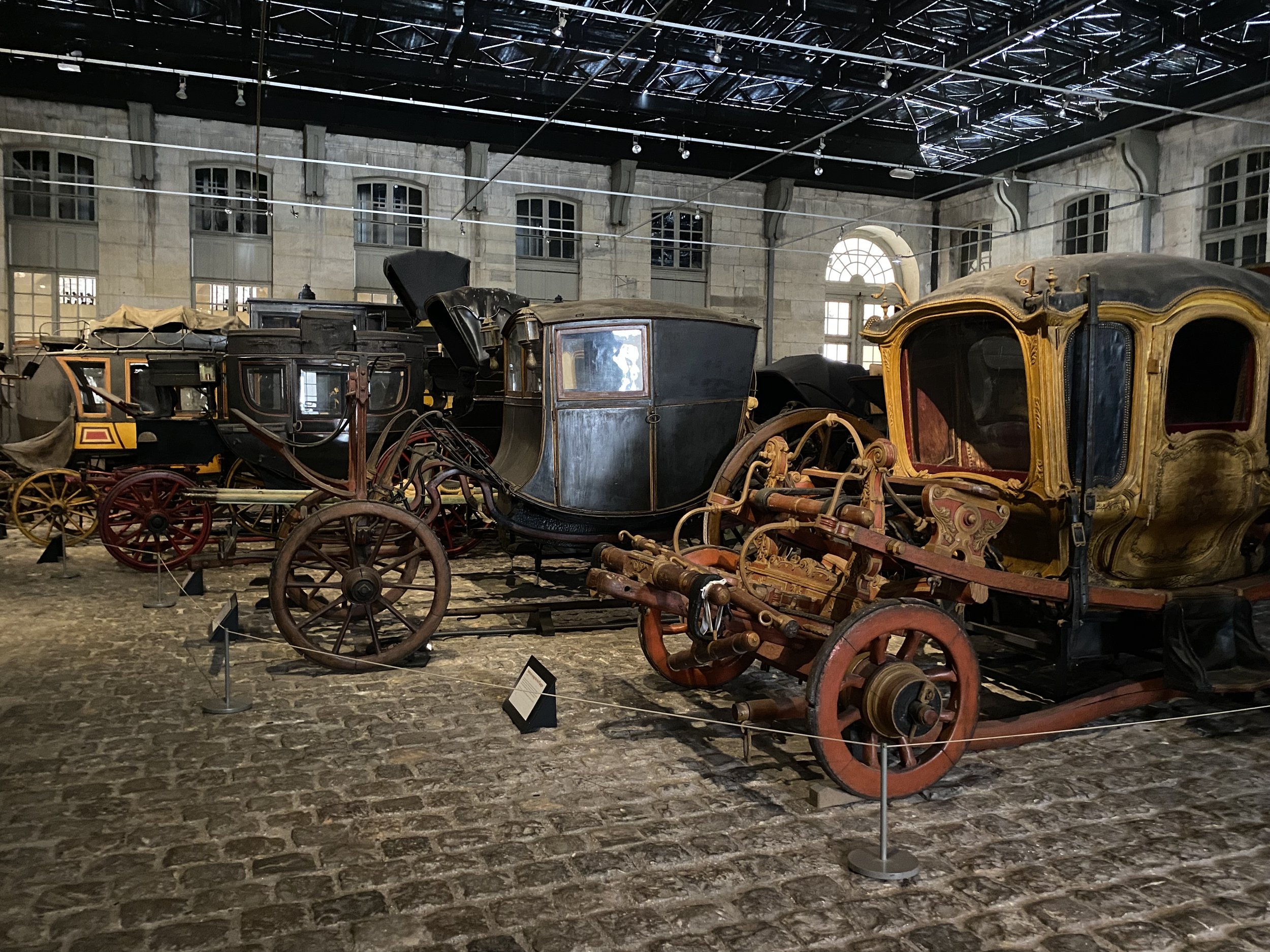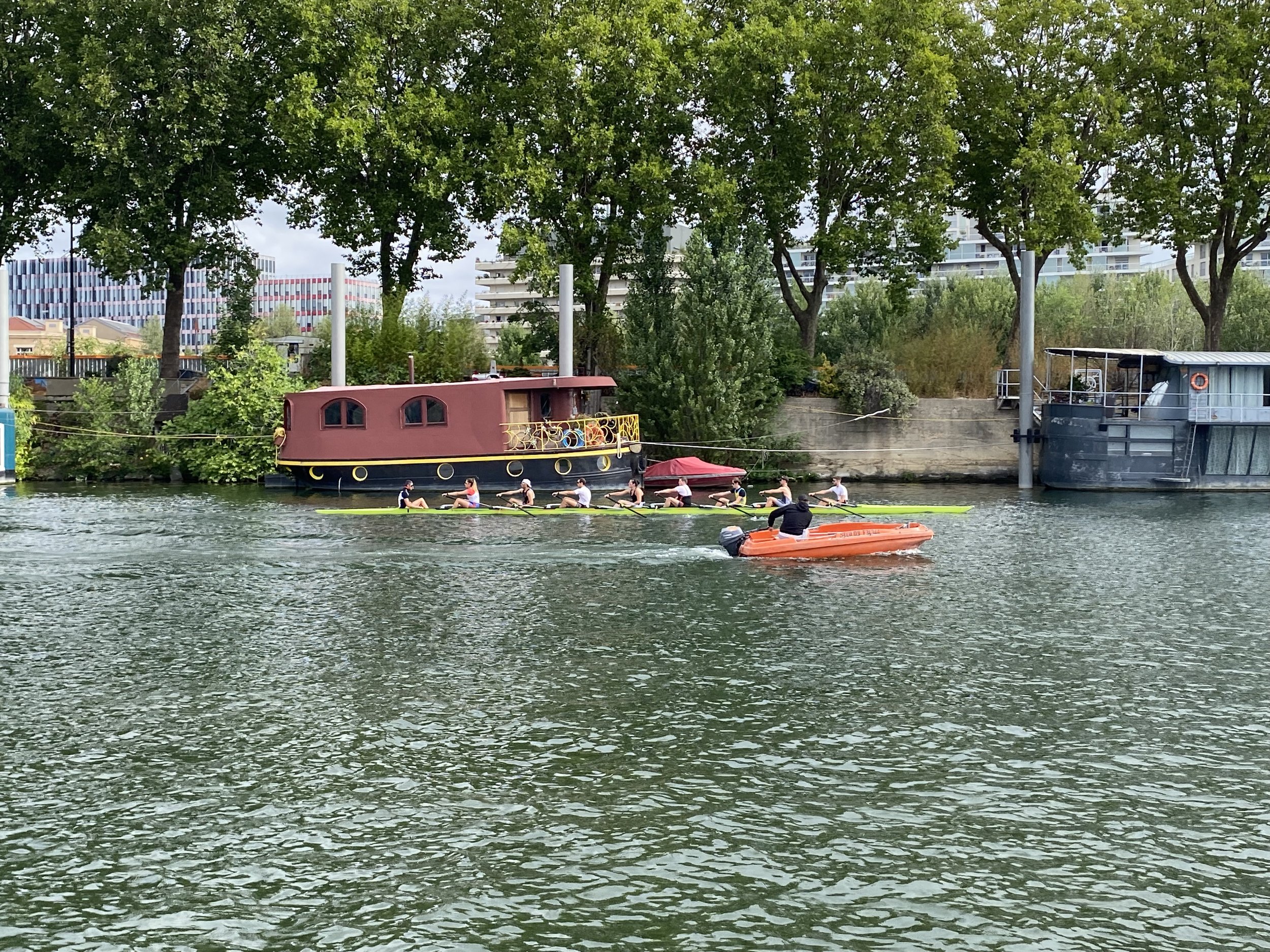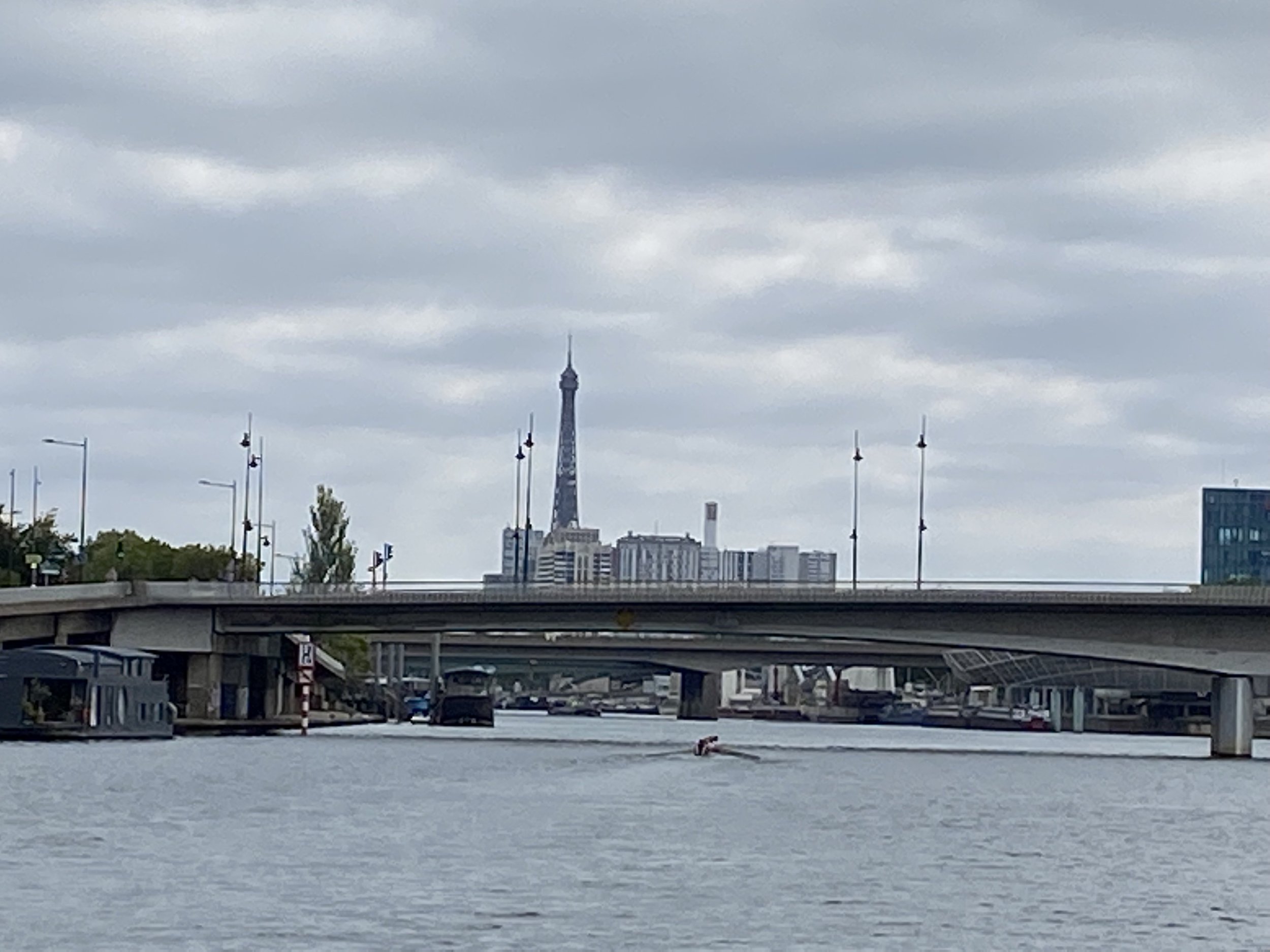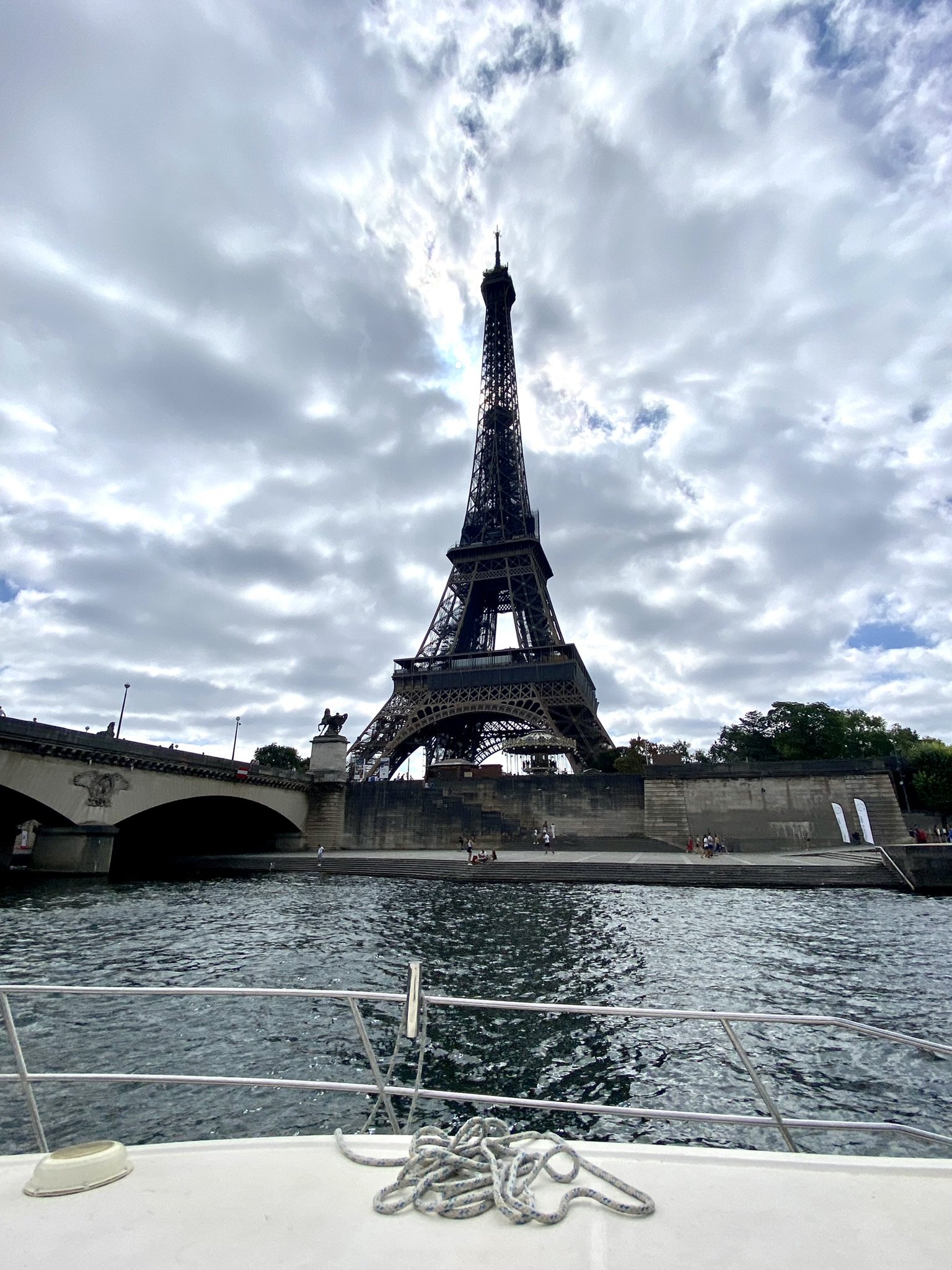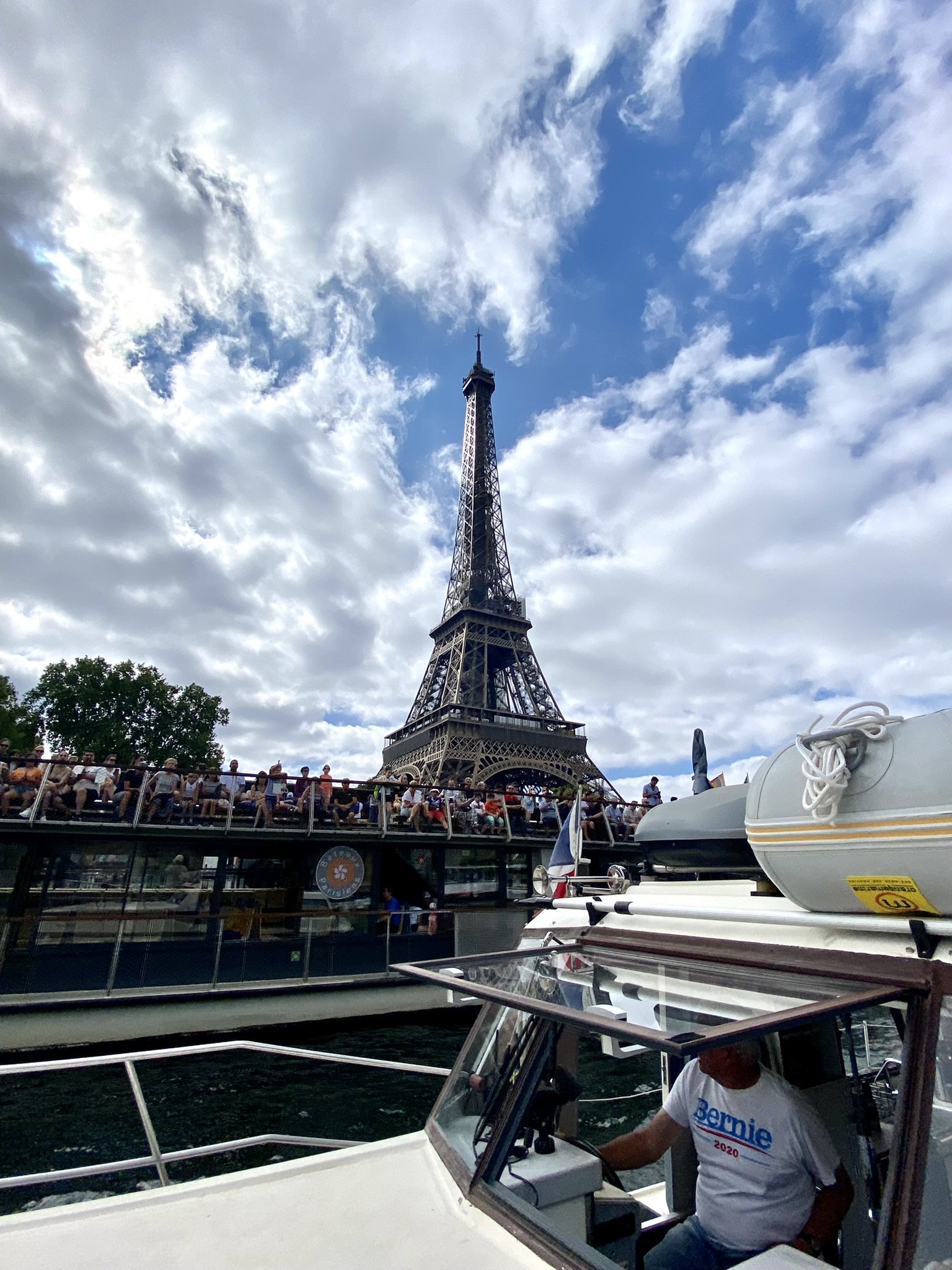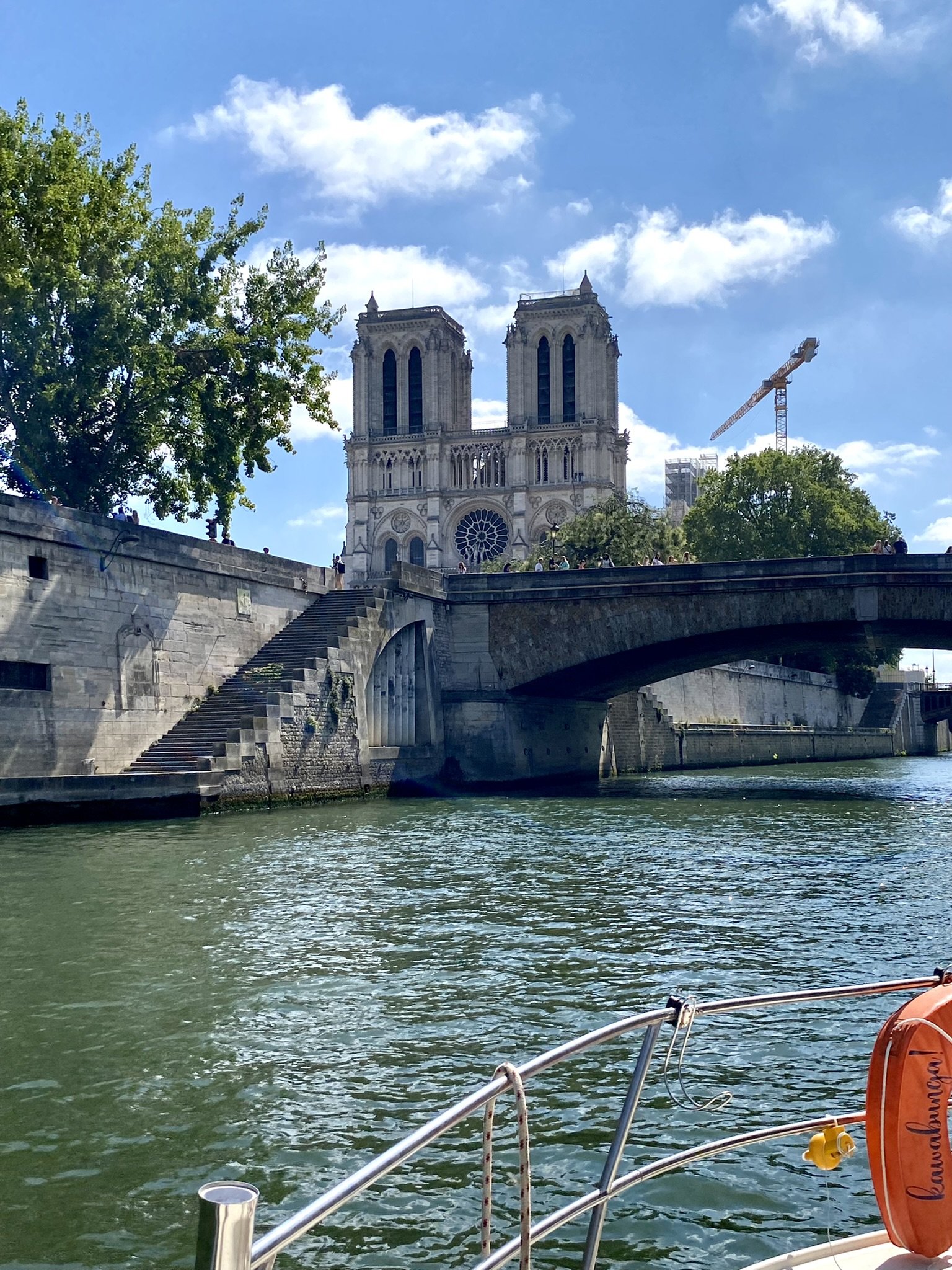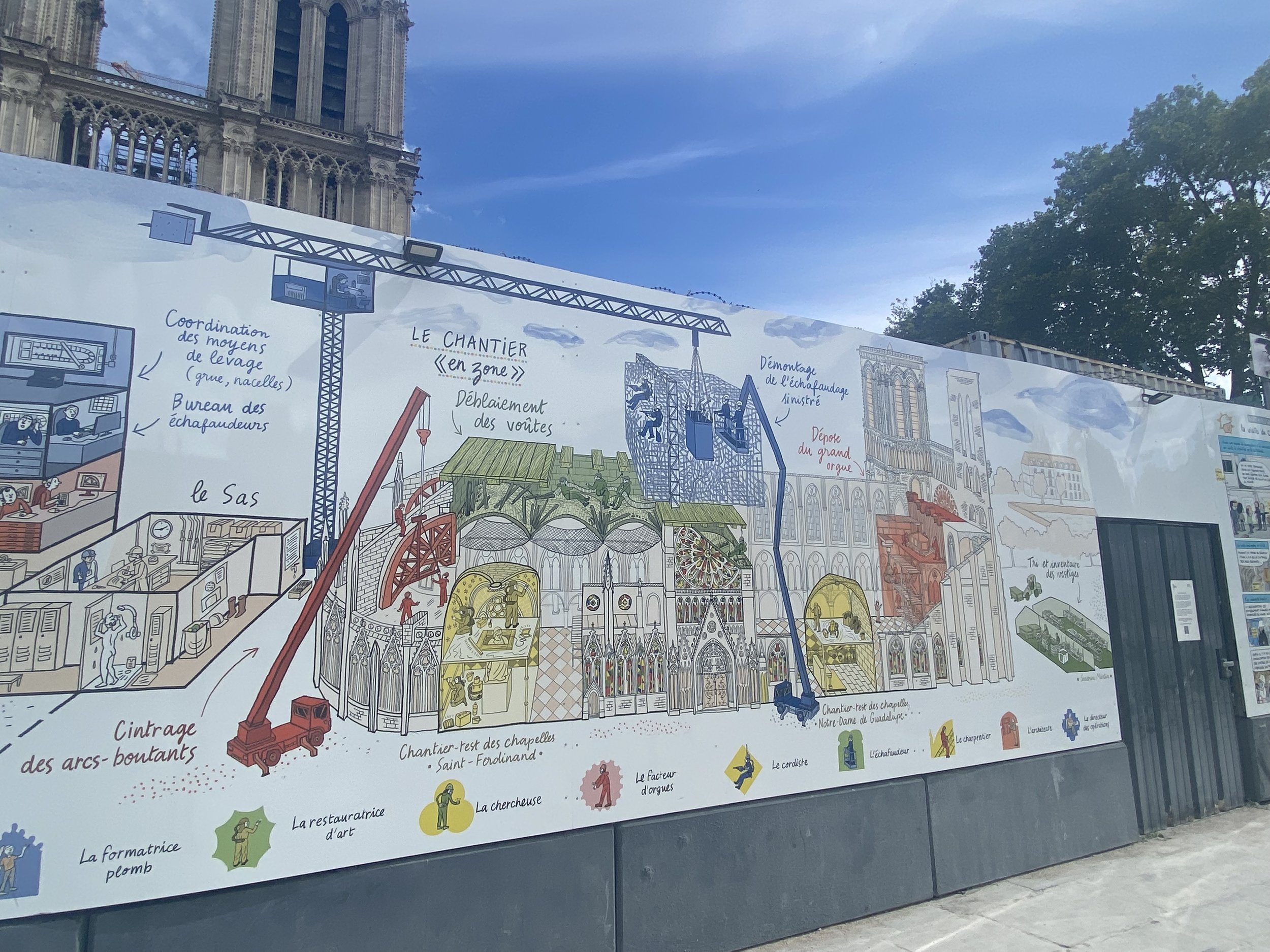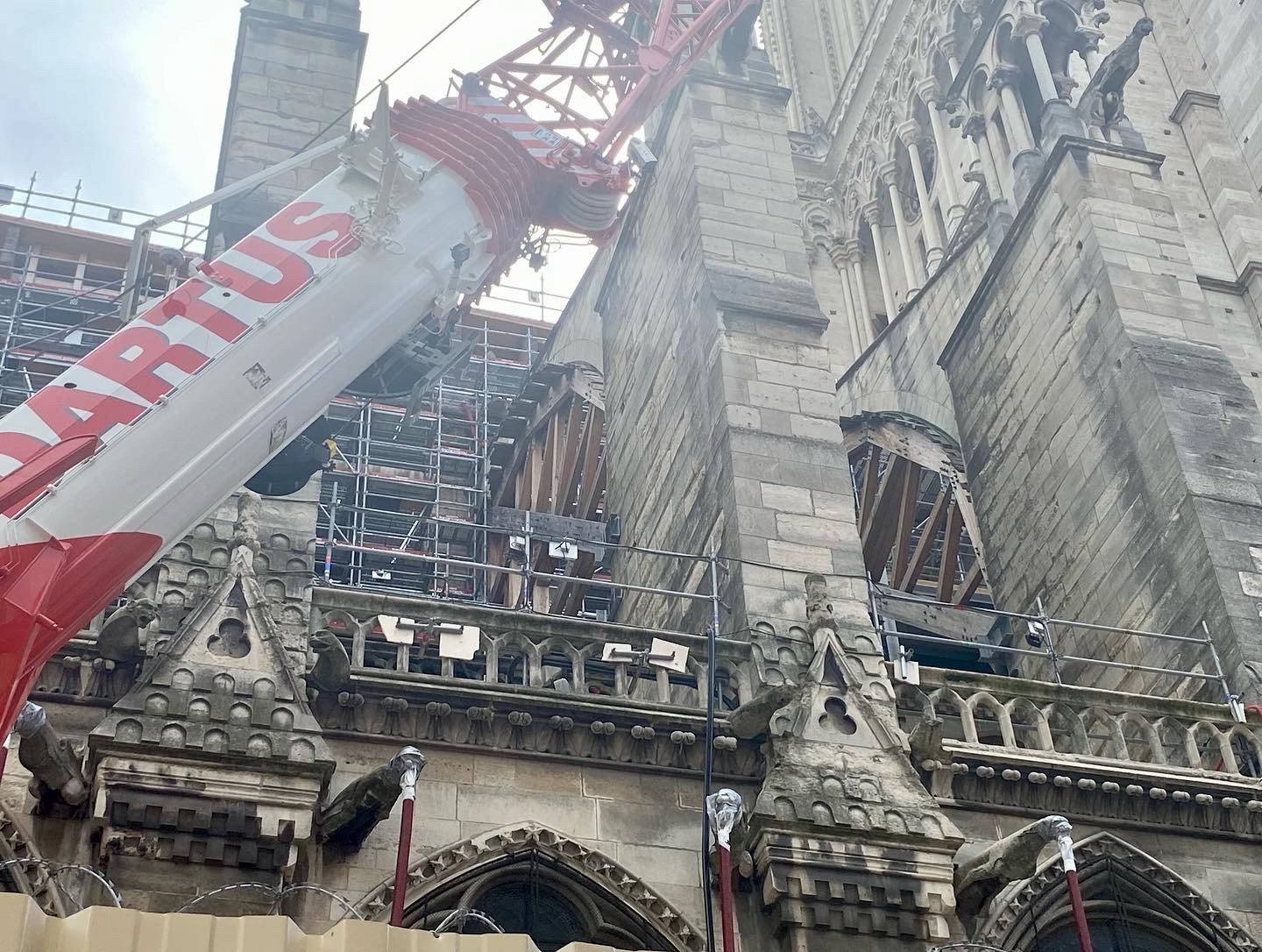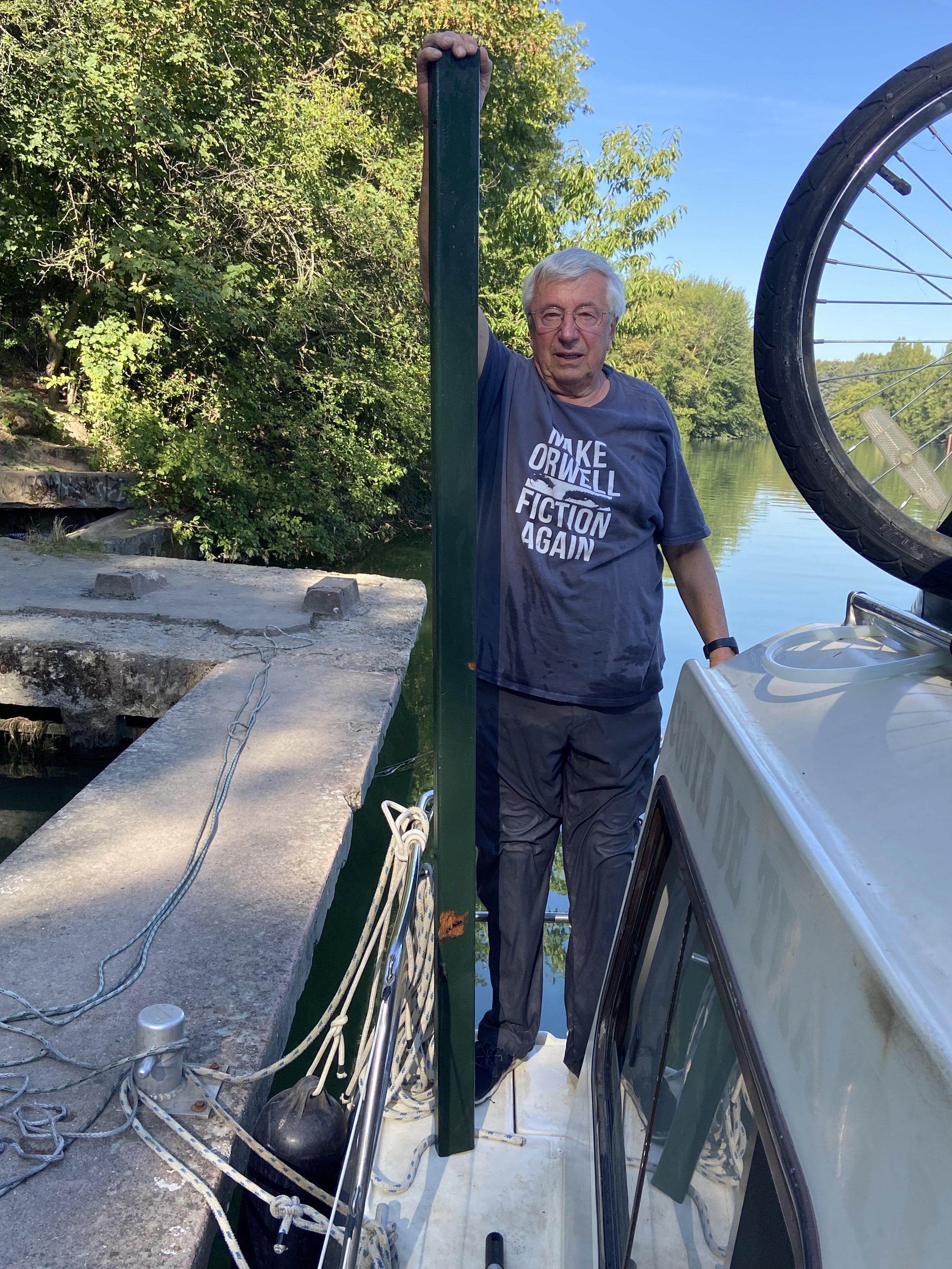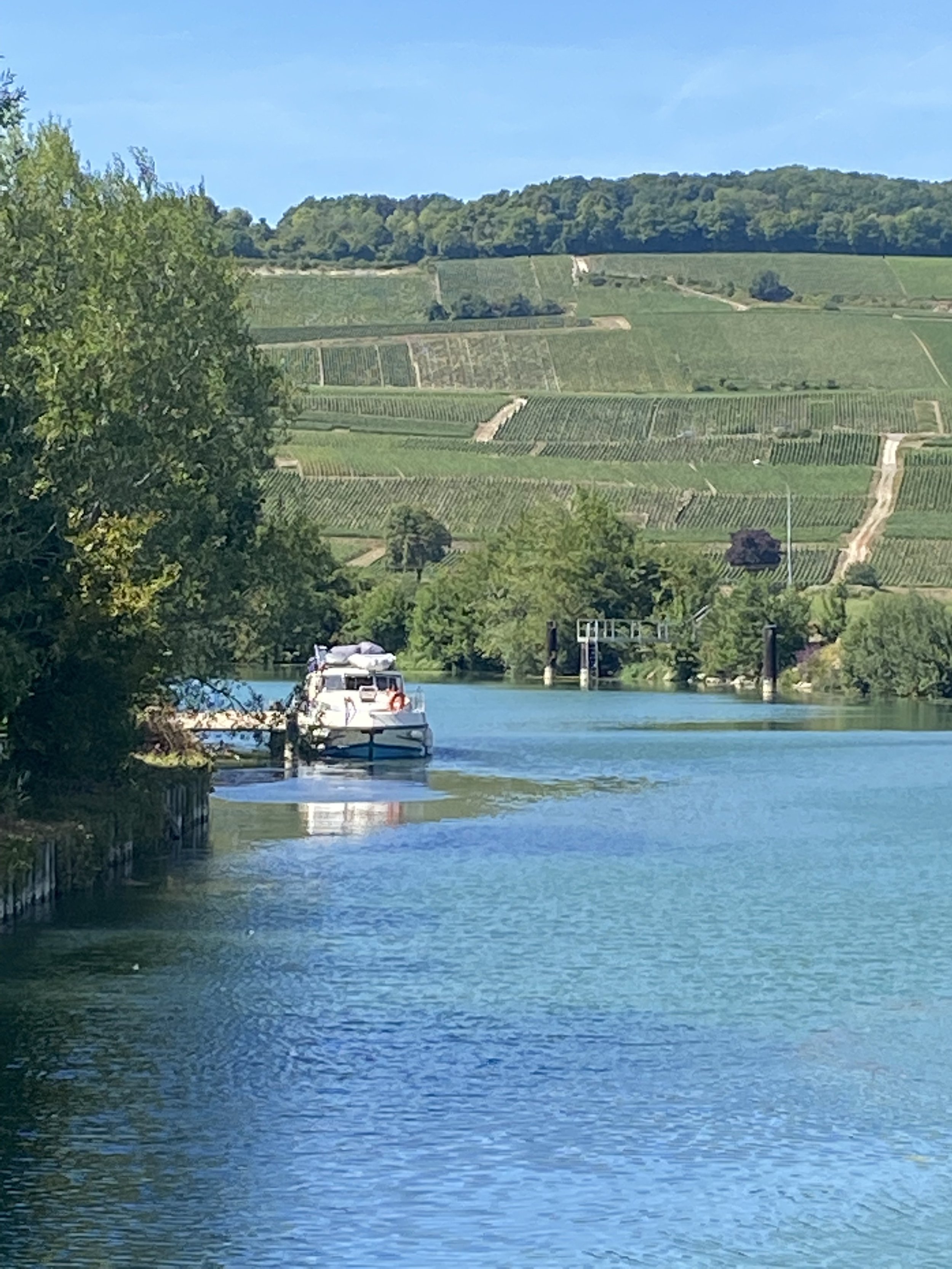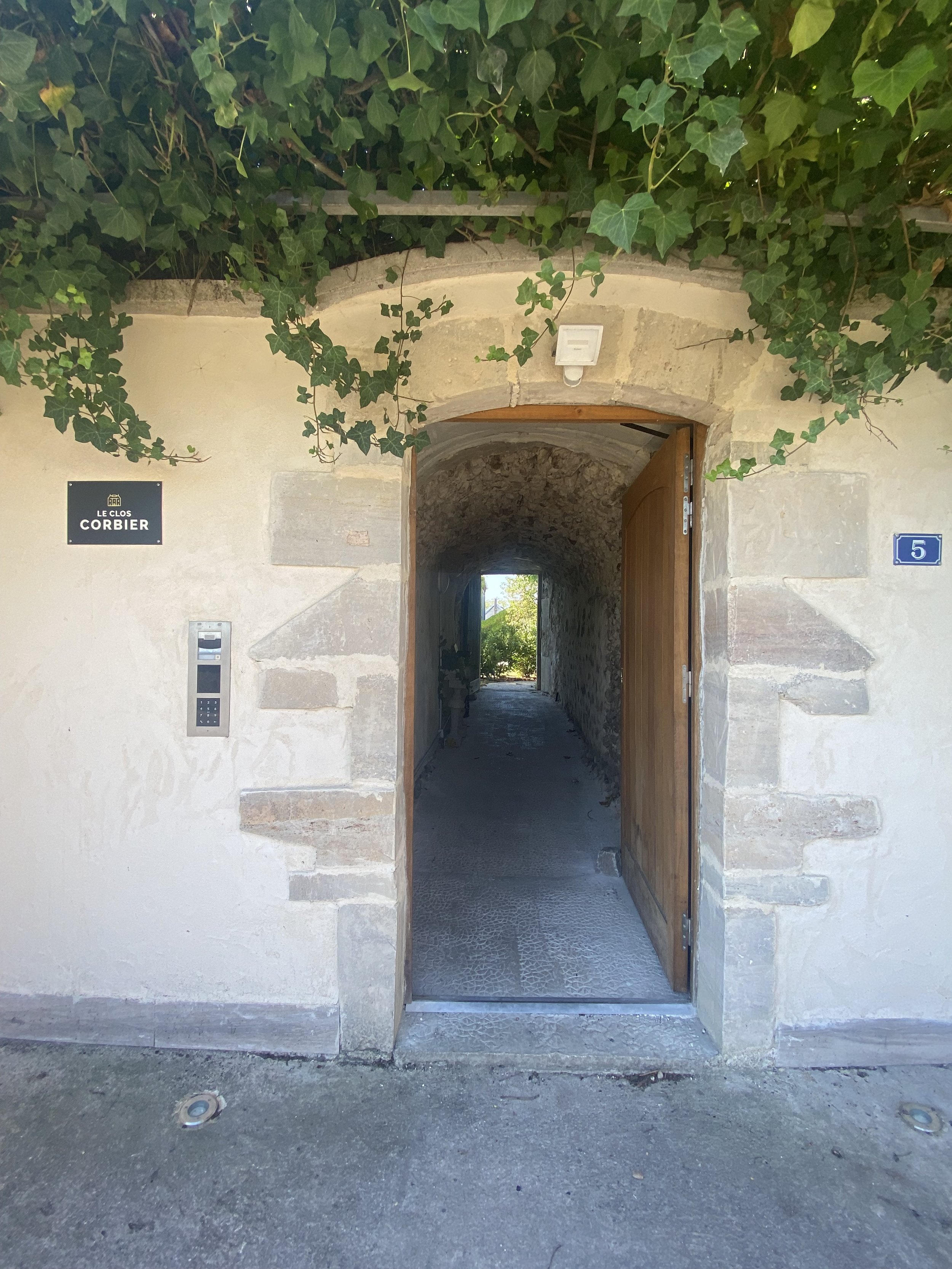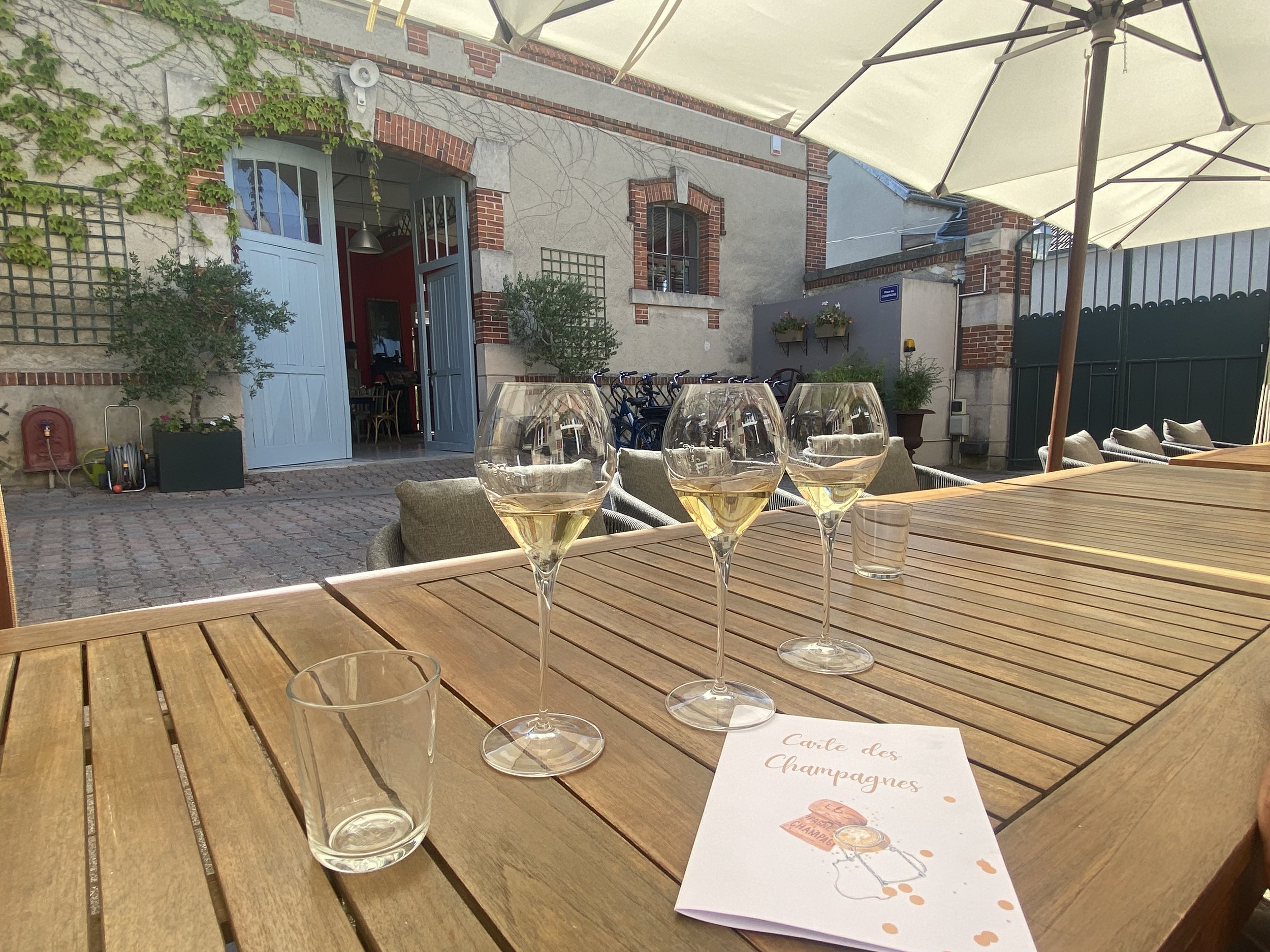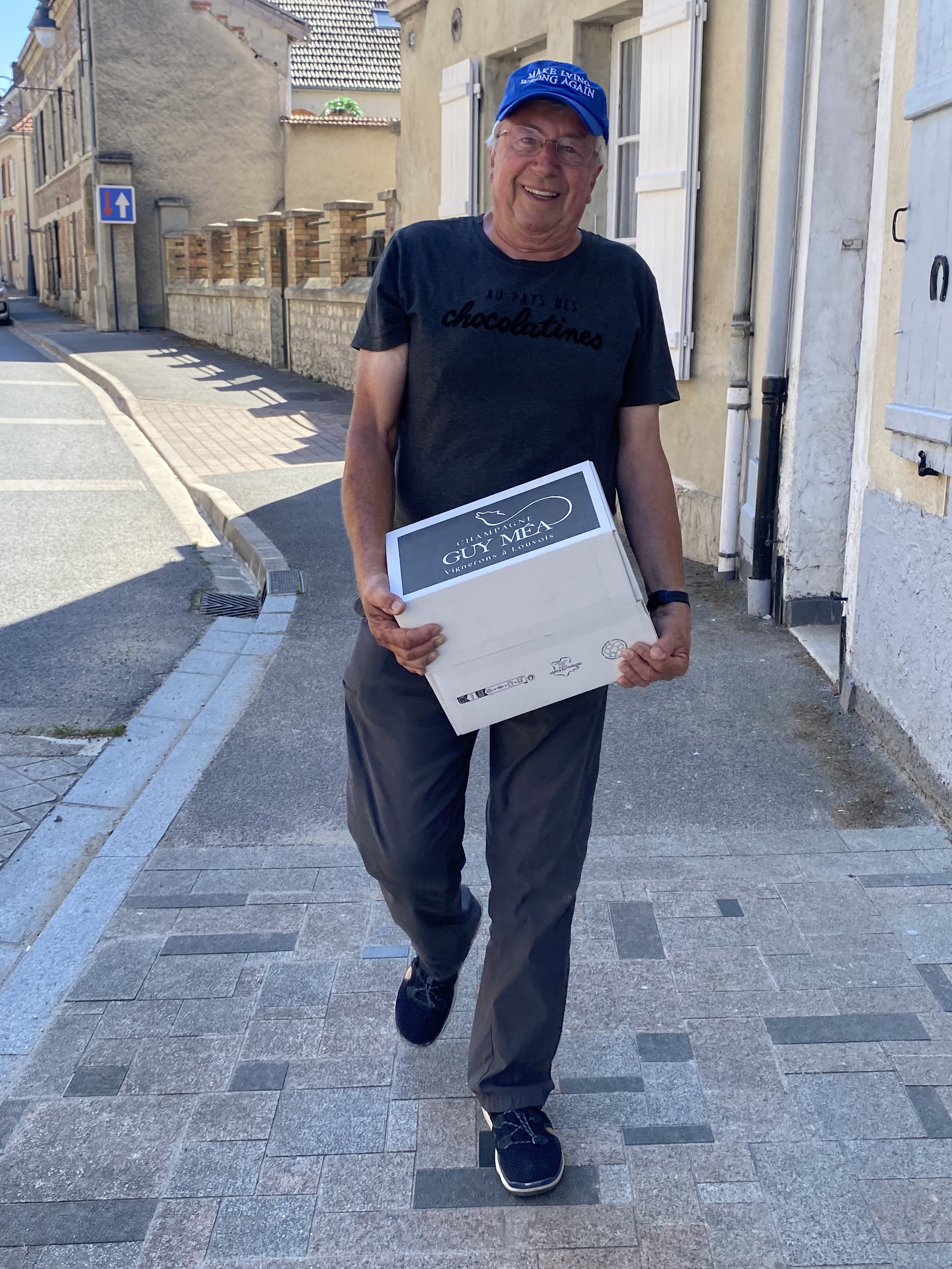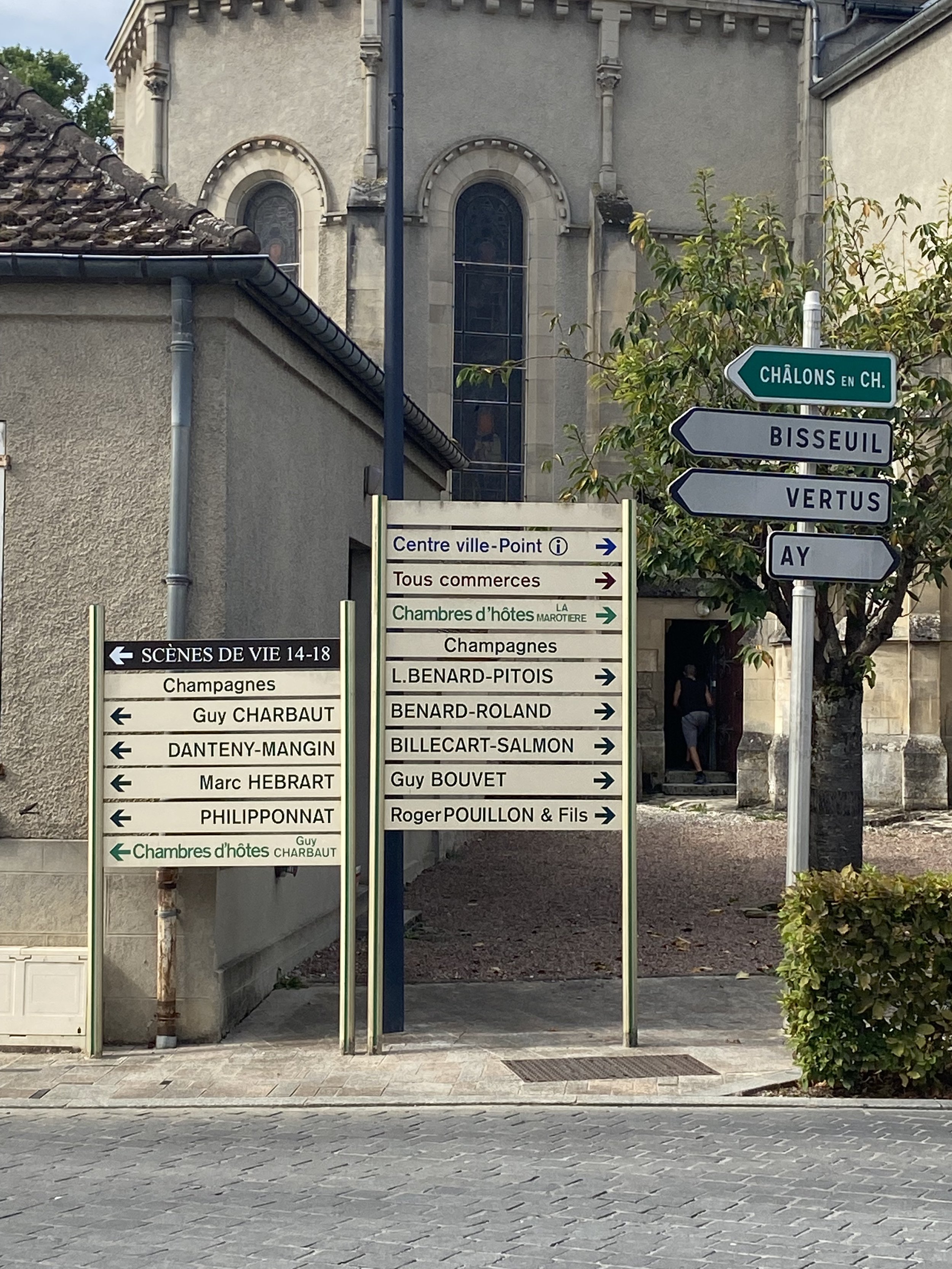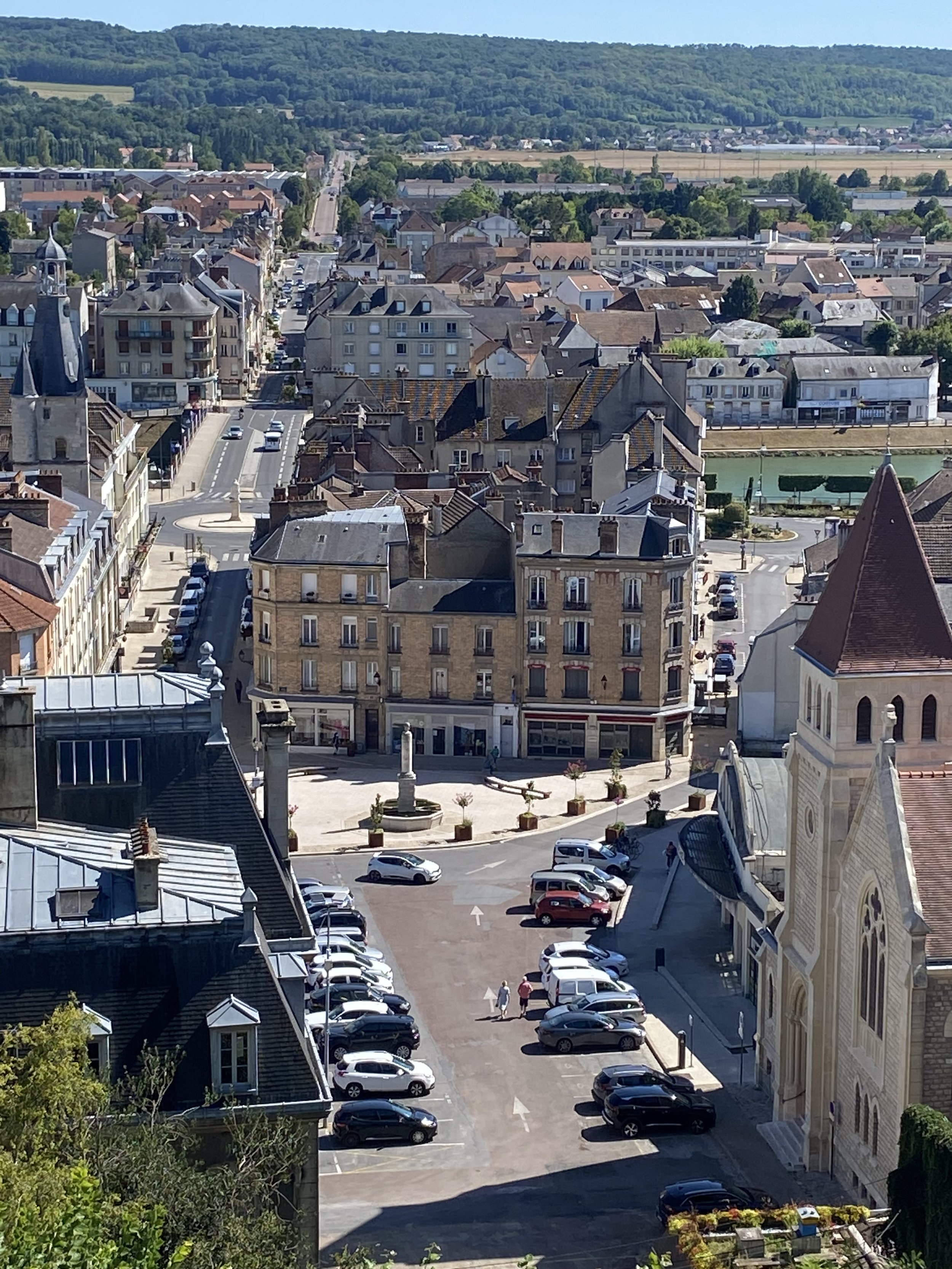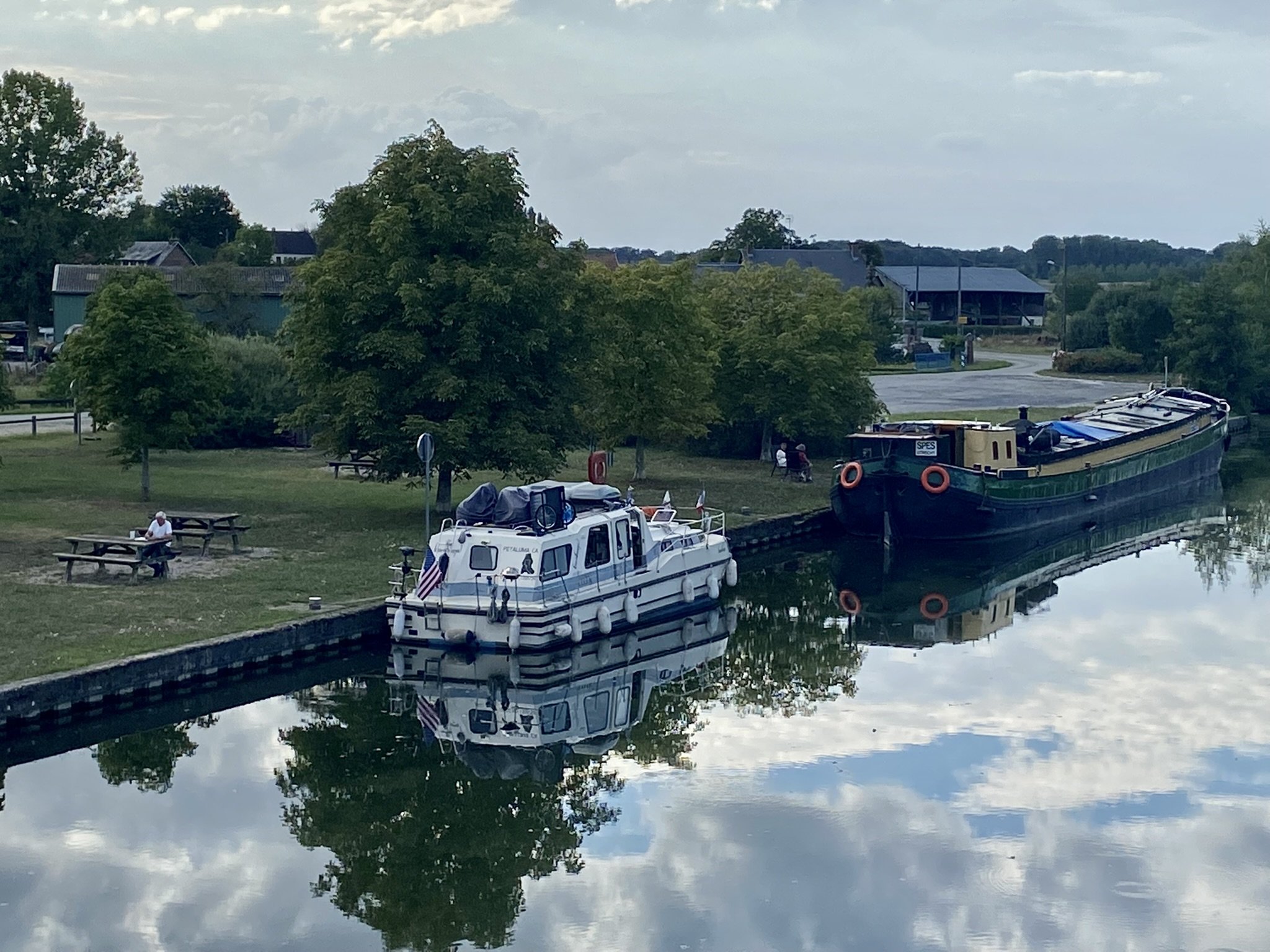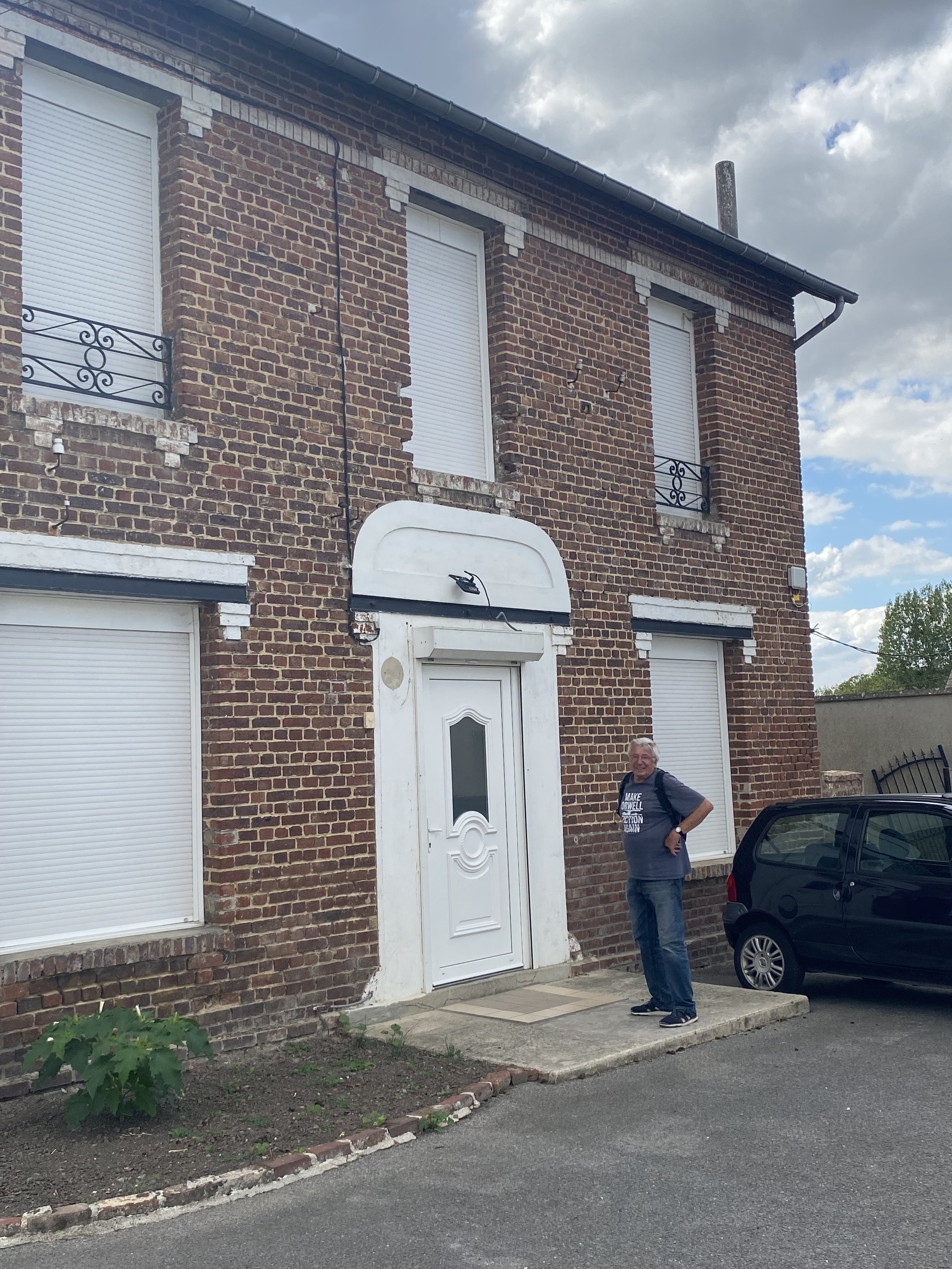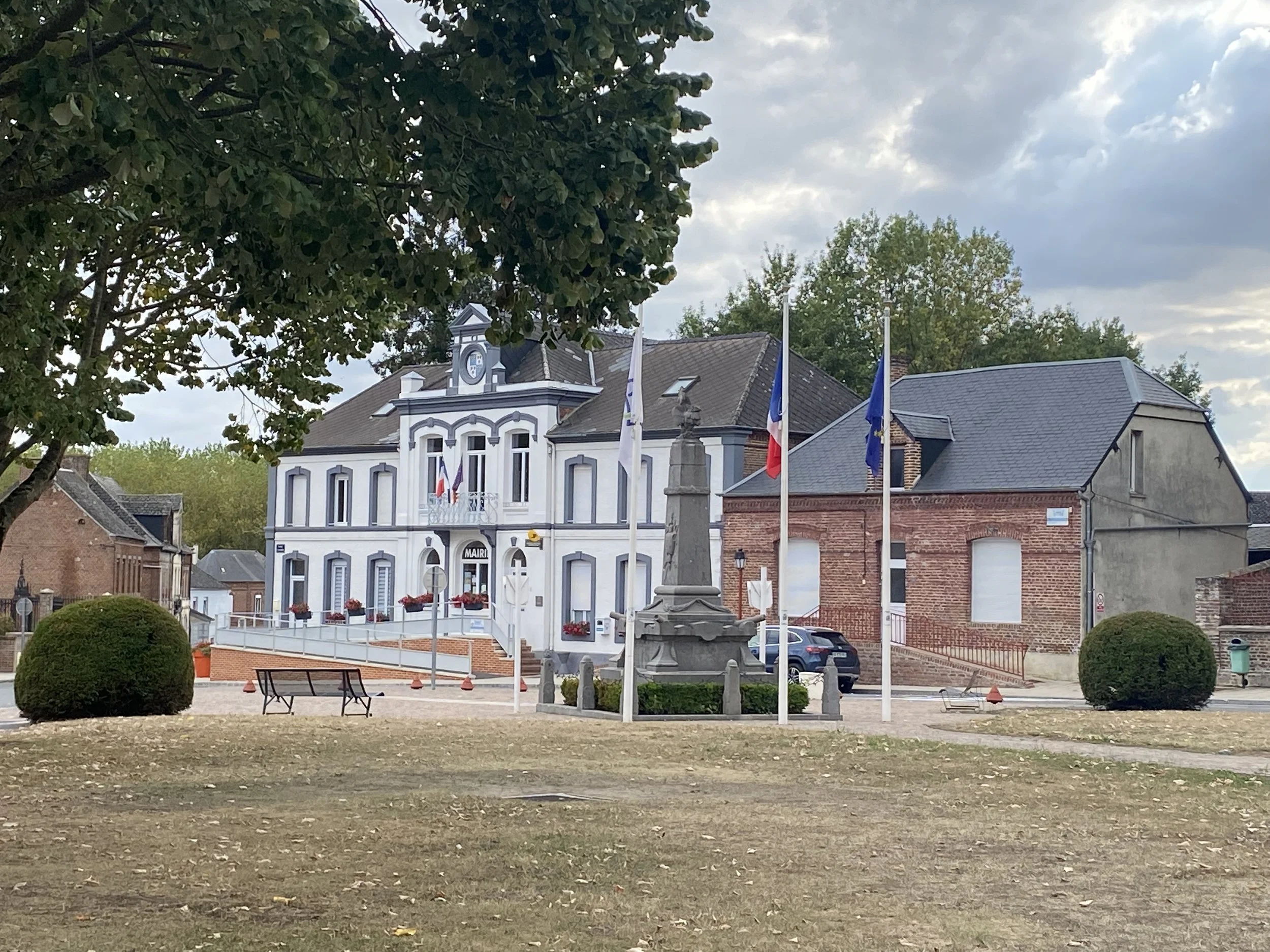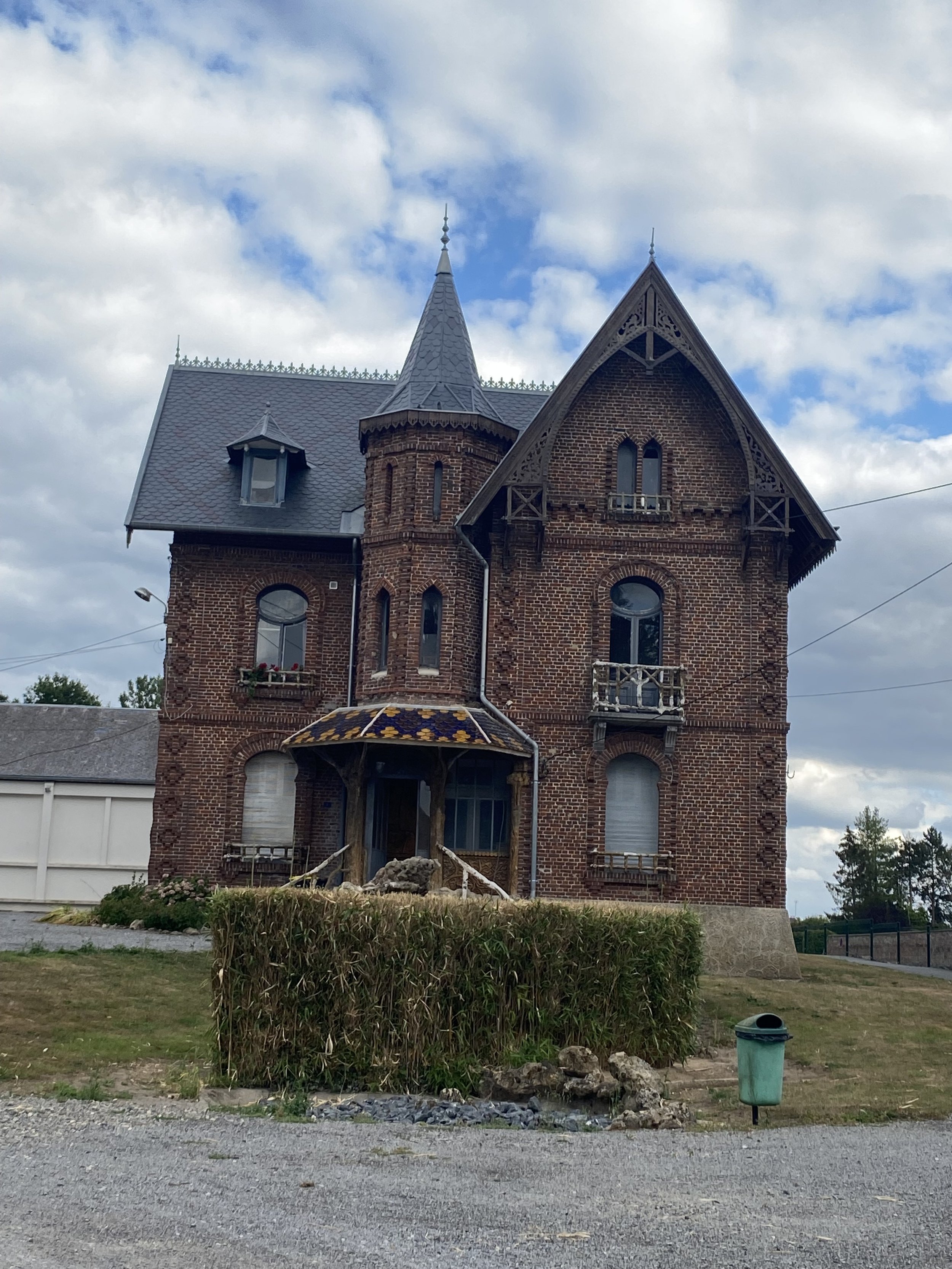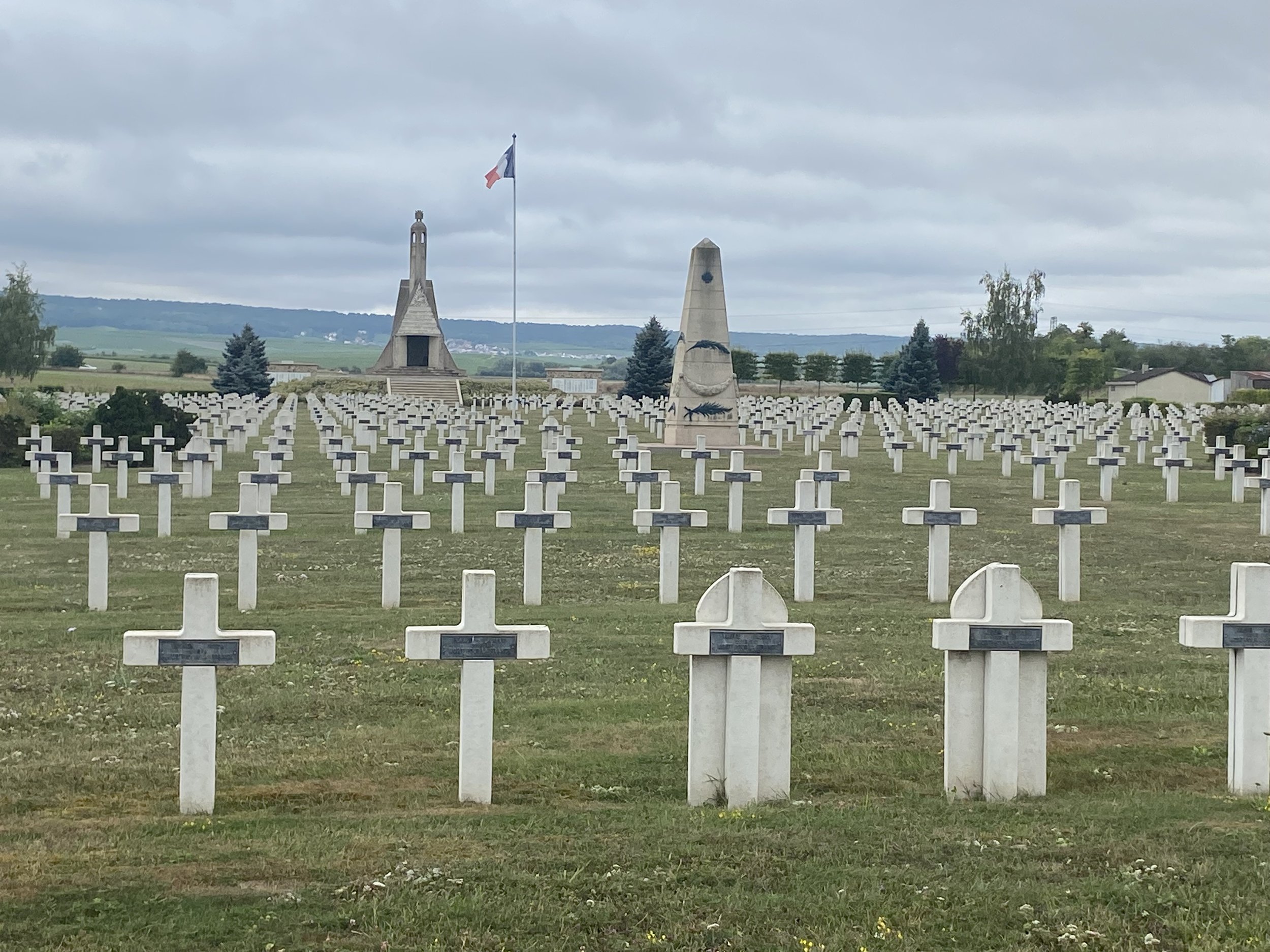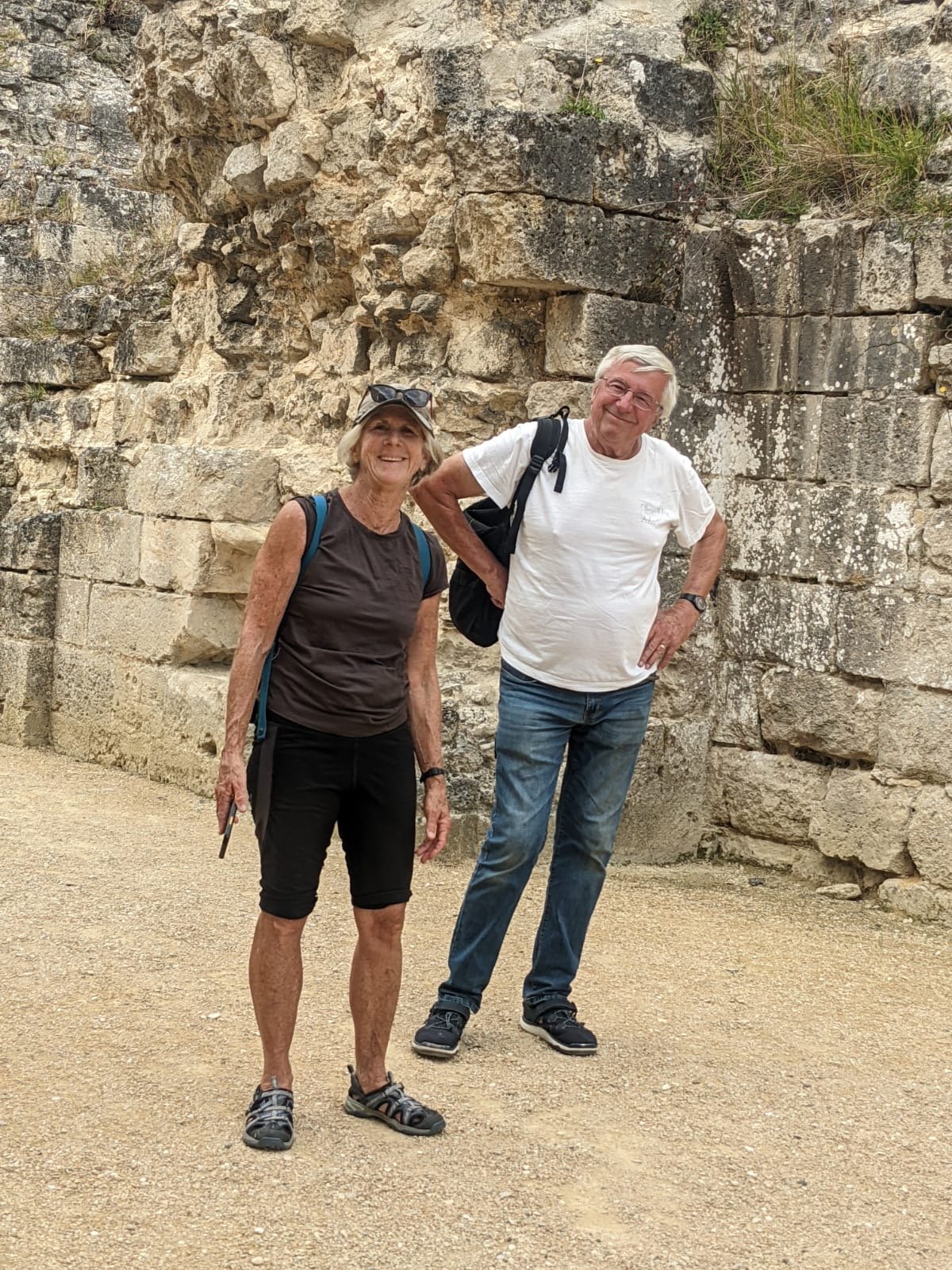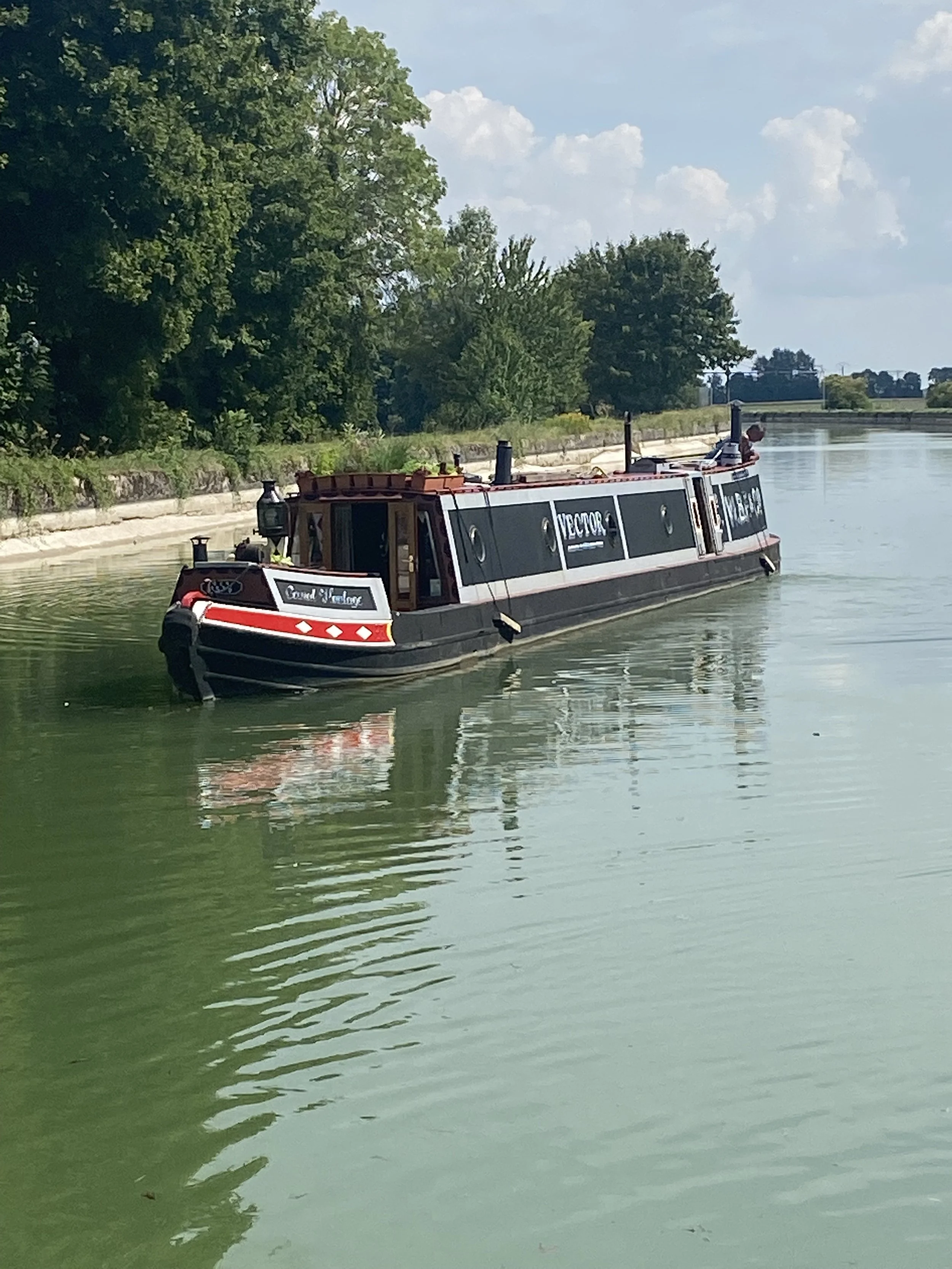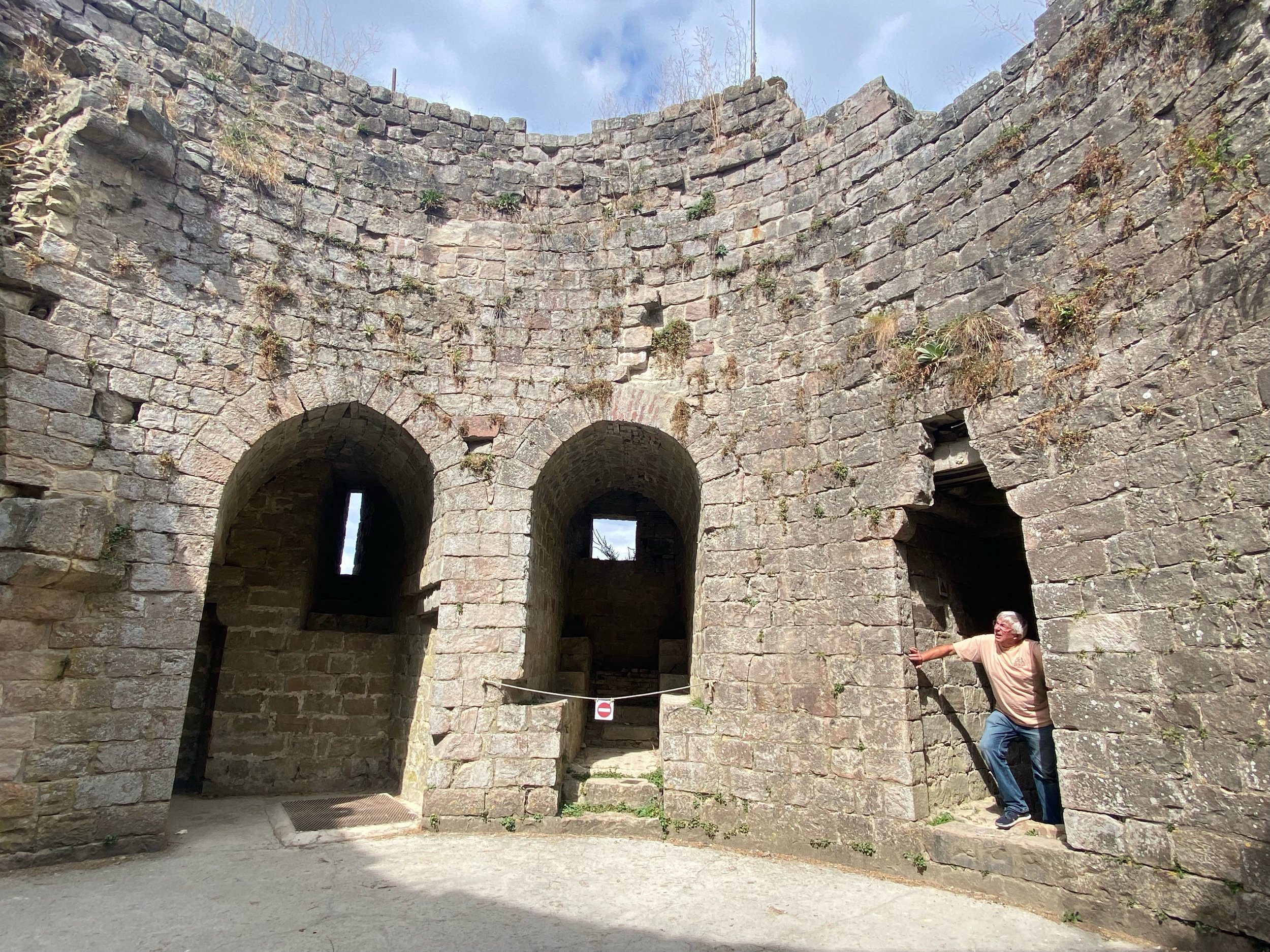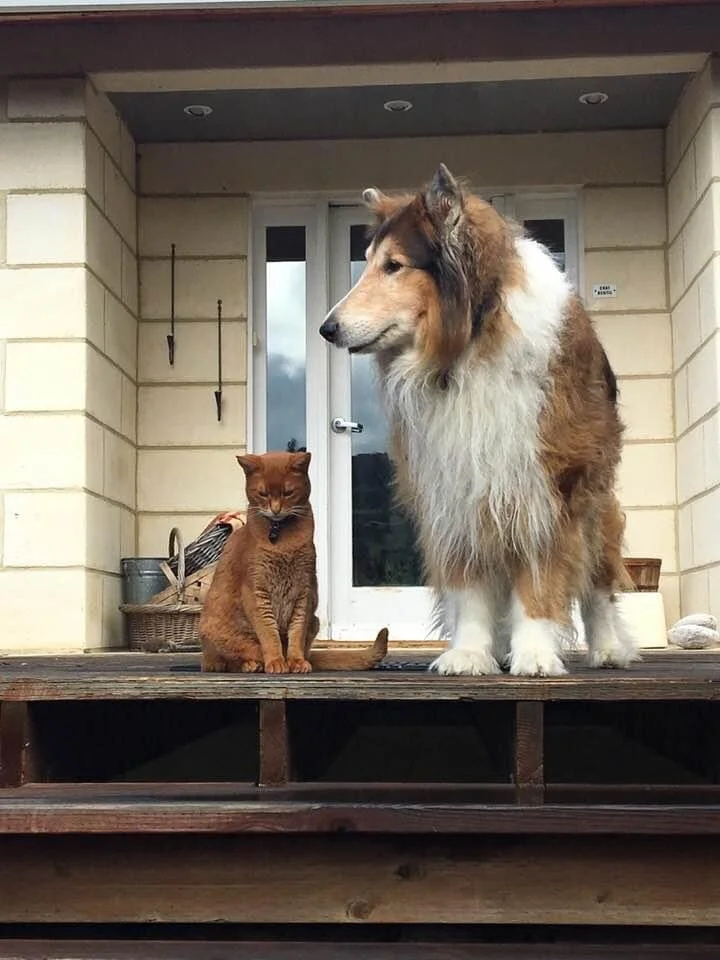Long Hot Summer / Un Long et Chaud Eté
/The locals knew how to keep cool!
ENGLISH
Some catching up to do!
I think we can all agree that wherever you were this summer, it was one hell of a summer—really, hot as hell. I’m not going to lie: navigating the “romantic” French countryside under these conditions was not always pleasant, nor a piece of cake. Michel can attest to my “more-often-than-not” grumpy, bad, heat-related moods that I was not a happy camper nor easy to live with. Of course, we are/were retired and on vacation, so I guess complaining falls in the category of being a “spoiled brat”?
From my last blog in mid-July, we meandered around northern France, with an unexpected dip into Paris, passing under the Eiffel Tower, Notre Dame, and other iconic Parisian landmarks along the Seine under our own power! Aside from our last minute jaunt to Paris, our time was spent in the North, which often gets bad-mouthed by the French: the source of cultural jokes stemming from the notorious year-round grey skies, chilly summers, guttural language accent, and occasional peculiar nouns for everyday objects that spring from the region’s traditional dialect. It’s a region marked by its coal mine past from the 1800s, and more recently economic hardships due to industrial flight contributing to the slow death of many villages. Furthermore, this region was front and center for some of the most vicious and horrendous battles of both WW I and II. The memories, memorials, stories, legends, and hallowed grounds are everywhere. For me, an American, coming from a land so isolated from such conflicts, plunging into this history was humbling and overwhelming. Michel’s and my own family histories are also entangled here as well in that Michel’s father was a French soldier in WW II (and a prisoner of war), my father landed in Normandy a week after D-Day headed into the Battle of the Bulge, and my sister-in-law’s German father-in-law was conscripted into the German army ranks. However, chilly grey skies were not on the radar this summer, and the locals proved friendly and welcoming.
Dotted black line from Bordeaux, up the rhône River, to Strasbourg denotes summer 2021 trip. Solid black lines and arrows show summer 2022 trip. A close-up map with more route explanations is below.
Michel’s parents were from Cambrai, and at one point after Michel’s first years in Germany (see previous blog), his family relocated to the Cambrai area. We glided right into Cambrai’s lovely little shaded harbor off the canal (seeking shelter from a heat wave!), and quickly found his grandfather’s house in town, as well as the street his mother lived on (the row houses no longer existing having been obliterated in WW II—and whereupon she was trapped inside for three days), and other family haunts. We initiated more childhood pilgrimages later on in the trip to the towns of St. Quentin, Wassigny (where Michel spent the formative years of 10-13, and has many distinct memories), Guise, and several others, all along various canal routes, and places where he recounts family trips and events from long past. It had been 60 years since his return to this area. He also found a longtime childhood friend, who still lives in his same house!
Shortly after leaving Cambrai we had the unique experience of being towed for almost two hours for 5 km (about 3 miles) through the Riqueval tunnel by a “toueur”—a unique boat tethered by a rooftop electrical cable system (somewhat reminiscent of some city trolley bus systems), and pulled along via an underwater chain grounded the whole length of the tunnel. This “tugboat” usually tows up to 30 boats (traditionally freight barges), but we were the only one this morning. Since the tunnel is not ventilated, boats must keep engines off, thus the necessity of being towed. Commandeered by the Germans in WW II, the tunnel became a fortress and munitions depot, and effectively dividing and sealing off the surrounding areas.
From here we headed south to Compiegne, a visit to its famed Palais, followed by a sudden change of plans to head down to Paris. From our personal floating craft we cruised the Seine, the heart of Paris, and the quaint Canal St Martin. Sweltering in Paris, docked in the Arsenal harbor at the foot of the famous Place de la Bastille, we looked up a few friends, and dined at our favorite seafood restaurant within walking distance at the Gare de Lyon. Braving another heat wave (we had no choice!) and leaving Paris, we sought shelter in the Champagne region where we discovered the lovely cities of Chateau Thierry (birthplace of children’s fable author LaFontaine) and Mareuil-sur-Ay, touted as the birthplace of Champagne, (and designated an Unesco Patrimoine site). Here a chance encounter with the mayor led us to a delightfully hidden Champagne “cave,” some tastings, and a fortunate purchase of some keen bubbly now safeguarded on board for future celebrations. Shortly thereafter, some Petaluma friends joined us for a few days on the Canal de l’Oise à l’Aisne, and we had the unique chance of mooring at a spot within “walking” distance (about an hour) to the impressive ruins of Coucy-le-Chateau, the oldest castle in France, that the Germans purposely destroyed in WW I as they retreated.
After the Allied D-Day invasion on Normandy June 6, 1944, many towns and areas in the north were consequently liberated as the armies marched on towards Germany. Just a few weeks ago, in early September, we passed through several towns that were observing, or about to observe, those momentous days. Aside from our revisiting Michel’s family history throughout this trip, it was also for me, a striking realization of how much this part of the world has been shaped by the devastating events of WW I and II and my own family history as well. We had the fortunate experience of meeting a wonderful British couple on their barge. He was retired from the British foreign service and somewhat of a history buff. We often came across meticulously kept WW I and II French, American, and British military cemeteries along the canal, or inside and outside villages. Our British gentleman noted that he always tries to visit such a cemetery when it comes across their path, just so that “someone still does.” We did too, and we will continue to do so. This is so removed from our American life, our daily livelihoods, and our continent that it’s hard to fathom.
Kawabunga is dry-docked in the town of Hautmont on the Sambre—just shy of the Belgian border—until next spring. France will be in our wake next summer as we head for Belgium and the Netherlands, and hopefully a tolerable summer!
Recap:
• Due to the extreme heat and lack of rain in France, many canals closed one right after the other; we got through many of them just in time.
• A fascinating exhibit at the Notre Dame fire reconstruction site explains the current ongoing monumental work.
• This was our year of mishaps: a fishnet caught in our propeller, a 6ft long board caught in our rudder, breakdown of our engine water pump—all while under power of course— and our four-year-old accessory 12V power batteries died, along with the battery charger, all making for some imaginative solutions on-the-go, ASAP!
• Somehow we have STILL managed to avoid catching Covid.
• Fascinating encounters amongst other boats: Australians; British; a Dutch/British couple that live on a barge in Holland but vacation on another; we reconnected with some boats we met last year; a Belgian family we had originally met many years ago in Petaluma (and who were wonderful tourist guides for us in their part of Belgium); and then there was Capucine: an attractive Parisienne who lives solo on her boat in Paris and inadvertently found herself traveling solo, through the locks.
• Total this year: 2,036 km, 447 locks (no wonder I was so tired!).
Leaving Strasbourg April 2022, up the Saar River to Germany (via Sarreguemines); back down to Nancy, up the Meuse to Verdun then Dinant and Namur, Belgium; continued in Belgium west and down to Valenciennes, France, then down to Cambrai via the Canal St Quentin; then southwest to Compiegne, followed by Paris on the Seine; east up the Marne to Champagne area, northwest to Reims; back towards St Quentin again but took a right at the fork in the canal northeast to Hautmont, final destination for winter storage, about 30 miles south of Belgium border (see orange circle).
FRANCAIS
Un peu de rattrapage à faire !
Je pense que nous sommes tous d'accord pour dire que, où que vous étiez cet été, c'était un été d'enfer - vraiment, chaud comme l'enfer. Je ne vais pas mentir : naviguer dans la campagne française "romantique" dans ces conditions n'était pas toujours agréable, ni un jeu d'enfant. Michel peut témoigner de mes humeurs "plus souvent qu'à mon tour", grincheuses, mauvaises, liées à la chaleur, que je n'étais pas toujours facile à vivre. Bien sur, nous sommes retraités et en vacances, alors je suppose que se plaindre entre dans la catégorie des "enfants gâtés"?
Depuis mon dernier blog, à la mi-juillet, nous nous sommes promenés dans le nord de la France, avec une incursion non prévue à Paris, passant devant la Tour Eiffel, Notre Dame et d'autres monuments parisiens emblématiques le long de la Seine et ce par nos propres moyens ! Mis à part cette escapade de dernière minute, nous avons passé beaucoup de temps dans le Nord, souvent décrié par les Français, source de blagues culturelles provenant du fameux ciel gris permanent, des étés froids, de l'accent guttural, et des noms particuliers occasionnels pour les objets du quotidien provenant du patois local. C'est une région marquée par son passé lié aux mines de charbon datant des années 1800 et, plus récemment, par les difficultés économiques dues à l'exode industriel qui a contribué à la mort lente de nombreux villages. En outre, cette région a été le théâtre de batailles parmi les plus vicieuses et les plus horribles de la première et de la deuxième guerre mondiale. Les souvenirs, mémoriaux, histoires, légendes et lieux sacrés sont partout. Pour moi, Américaine, venant d'une terre si isolée de ces conflits, plonger dans cette histoire a été une leçon d'humilité et une expérience bouleversante. L'histoire de la famille de Michel et la mienne s'entremêlent également, puisque le père de Michel était un soldat français de la Seconde Guerre mondiale (et un prisonnier de guerre), que mon père a débarqué en Normandie une semaine après le jour J pour se lancer dans la bataille des Ardennes, et que le beau-père allemand de ma belle-sœur a été enrôlé dans les rangs de l'armée allemande. Cependant, les cieux gris et froids n'étaient pas sur le radar cet été, et les habitants se sont montrés amicaux et accueillants.
Les parents de Michel étaient originaires de Cambrai, et à un moment donné, après les premières années de Michel en Allemagne (voir le blog précédent), sa famille s'est installée dans la région de Cambrai. Nous sommes entrés directement dans le charmant petit port ombragé de Cambrai au bord du canal (en cherchant à nous abriter d'une vague de chaleur !), et nous avons rapidement trouvé la maison de son grand-père en ville, ainsi que la rue où vivait sa mère (les maisons en rangée n'existant plus car détruites pendant la Seconde Guerre mondiale - et elle y est restée coincée pendant trois jours), et d'autres repaires familiaux. Plus tard dans le voyage, nous avons entrepris d'autres pèlerinages d'enfance dans les villes de Saint-Quentin, Wassigny (où Michel a passé ses années d'adolescence de 10 à 13 ans et dont il a de nombreux souvenirs), Guise et plusieurs autres villages situés le long de diverses routes ou canaux, liés à des voyages et des événements familiaux du passé. Cela faisait 60 ans qu'il n'était pas revenu dans cette région. Il a également retrouvé un vieil ami d'enfance qui vit toujours dans la même maison !
Peu après avoir quitté Cambrai, nous avons vécu l'expérience unique d'être remorqués pendant plus de deux heures sur 5 km dans le tunnel de Riqueval par un "toueur" - un bateau unique en son genre, relié à un système de câbles électriques aériens (qui rappelle un peu les systèmes de trolleybus de certaines villes), et tiré par une chaîne sous-marine sur toute la longueur du tunnel. Ce "remorqueur" tire habituellement jusqu'à 30 bateaux (traditionnellement des barges de fret), mais nous étions les seuls ce matin. Comme le tunnel n'est pas ventilé, les bateaux doivent garder leurs moteurs éteints, d'où la nécessité d'être remorqué. Réquisitionné par les Allemands pendant la Seconde Guerre mondiale, le tunnel était devenu une forteresse et un dépôt de munitions.
De là, nous nous sommes dirigés vers le sud jusqu'à Compiègne, où nous avons visité son célèbre Chateau. Puis, soudainement, nous avons changé nos plans pour nous rendre à Paris. Depuis notre embarcation personnelle, nous avons fait une croisière sur la Seine, le cœur de Paris, et le pittoresque Canal St Martin. Après avoir accosté dans le port de l'Arsenal, au pied de la célèbre place de la Bastille, nous avons retrouvé quelques amis et avons dîné dans notre restaurant de fruits de mer préféré, situé à quelques pas de la gare de Lyon. Bravant une nouvelle vague de chaleur (nous n'avions pas le choix !) et quittant Paris, nous nous sommes réfugiés dans la région de Champagne où nous avons découvert les charmantes villes de Château Thierry (lieu de naissance de l'auteur de fables pour enfants LaFontaine) et Mareuil-sur-Ay, présenté comme le berceau du champagne (et classée au patrimoine de l'Unesco). Là, une rencontre fortuite avec le maire nous a conduits à une "grotte" à champagne délicieusement cachée, et à des dégustations et achat heureux de quelques bulles bien senties, désormais conservées à bord pour de futures célébrations. Peu de temps après, des amis de Petaluma nous ont rejoints pour quelques jours sur le Canal de l'Oise à l'Aisne, et nous avons eu la chance unique d'amarrer à un endroit situé à une distance de marche (environ une heure) des ruines impressionnantes de Coucy-le-Château, le plus ancien château de France, que les Allemands ont délibérément détruit pendant la première guerre mondiale lors de leur retraite.
Après le débarquement des Alliés en Normandie le 6 juin 1944, de nombreuses villes et régions du nord ont été libérées alors que les armées marchaient vers l'Allemagne. Il y a quelques semaines, au début du mois de septembre, nous avons traversé plusieurs villes qui observaient, ou étaient sur le point d'observer, ces journées capitales. Outre le fait que nous avons revisité l'histoire de la famille de Michel tout au long de ce voyage, j'ai également réalisé de façon frappante à quel point cette partie du monde a été façonnée par les événements dévastateurs de la Première et de la Deuxième Guerre mondiale, ainsi que par ma propre histoire familiale. Nous avons eu la chance de rencontrer un merveilleux couple britannique sur leur péniche. Il était retraité du service extérieur britannique et un peu féru d'histoire. Nous avons souvent rencontré des cimetières militaires français, américains et britanniques de la première et de la deuxième guerre mondiale, méticuleusement entretenus, le long du canal, ou à l'intérieur et à l'extérieur des villages. Notre gentleman britannique a fait remarquer qu'il essaie toujours de visiter un tel cimetière lorsqu'il croise son chemin, juste pour que "quelqu'un le fasse encore". Nous l'avons fait aussi, et nous continuerons à le faire. C'est tellement éloigné de notre vie américaine, de nos moyens de subsistance quotidiens et de notre continent que c'est difficile à comprendre.
Le Kawabunga est mis en cale sèche dans la ville de Hautmont sur la Sambre - juste avant la frontière belge - jusqu'au printemps prochain. L'été prochain, la France sera dans notre sillage puisque nous nous dirigerons vers la Belgique et les Pays-Bas, en espérant que l'été sera supportable !
Récapitulation :
• En raison de la chaleur extrême et du manque de pluie en France, de nombreux canaux ont fermé l'un après l'autre ; nous en avons traversé beaucoup juste à temps.
• Une exposition fascinante sur le site de reconstruction de l'incendie de Notre Dame explique le travail monumental en cours.
• Cette année a été marquée par de nombreuses mésaventures : un filet de pêche s'est coincé dans notre hélice, une planche de 1,80 m de long s'est coincée dans notre gouvernail, la pompe à eau du moteur est tombée en panne - tout cela en étant en navigation, bien sûr - et nos batteries 12 V accessoires, vieilles de quatre ans, sont mortes, ainsi que le chargeur de batterie, ce qui nous a obligé à trouver des solutions imaginatives en route, le plus vite possible !
• D'une manière ou d'une autre, nous avons TOUJOURS réussi à ne pas attraper de Covid.
• Des rencontres fascinantes avec d'autres bateaux : Des Australiens, des Britanniques, un couple hollandais/britannique qui vit sur une péniche en Hollande mais passe ses vacances sur une autre; nous avons repris contact avec des bateaux que nous avions rencontrés l'année dernière; une famille belge que nous avions rencontrée il y a de nombreuses années à Petaluma (et qui nous ont fait découvrir leur région de Belgique) ; et puis il y a eu Capucine : une jolie Parisienne qui vit seule sur son bateau à Paris et qui s'est retrouvée par inadvertance à voyager seule, à travers les écluses.
• Total cette année : 2 036 km, 447 écluses (pas étonnant que j'étais si fatiguée !).
Michel’s grandfather’s house in Cambrai
The rebuilt street where Michel’s mother’s house was originally located, and where she was trapped inside the bombed ruins for three days.
Cambrai
Cambrai
The "toueur"
As we are exiting the "toueur" tunnel; this same tunnel was commandeered by the German army during WW II, sealed off and used as an important base and munitions depot.
Military cemetery in Cambrai
A mooring well encumbered with canal “weeds”—a real problem in the heat and drought-stricken canals this summer.
We were the only ones moored in this idyllic, hidden lagoon.
Saint Quentin—not quite the one we know in California!
Typical northern French brick village.
Compiegne: iconic French street scene.
Palais de Compiegne
Palais de Compiegne
Carriage museum, Palais de Compiegne
The scars of wars on the walls of the Palais
Coming into Paris…
Getting closer…
And closer….
Et nous voilà!
Us and the tourist hop-on/hop-off boats
View from Kawabunga, in the heart of Paris, on the Seine
On the street in Paris: Opening a can of worms! They said it all made sense to them!
Repairing Notre Dame
Present from Paris: this was caught in our rudder!
Lagny on the Marne, after leaving Paris: “sundowner” tube rentals, complete with BBQ and all the necessities for Happy Hour
Swan sunset from our mooring
Entering Champagne region , from the Canal de la Marne.
We could see Champagne from our backyard.
The secret door to…
This!
Inevitable outcome, purchased at the source
Kawabunga moored in distance on left, at foot of Champagne vineyards, Mareuil sur Ay
View from our deck
The most important directions in this Champagne village
City of Chateau Thierry, Champagne region
Evening mooring near Coucy le Chateau, having exited Champagne region
The chateau at Coucy le Chateau
Another childhood abode, this in the Gendarmerie compound of Wassigny, where Michel’s father was the chief Gendarme.
Town of Wassigny; the first time Michel returned in over 60 years
Administration school building where Michel attended middle school
Another of MANY military cemeteries scattered throughout the north of France for both world wars
Unfathomable
Yours truly playing tourist on chateau grounds (and getting a break from maneuvering in the locks!)
You can count on the British to have their weird twist on what a canal boat should be: a typical English “narrow boat”.
Chateau de Guise
Chateau de Guise, where Michel worked as a part of a group of young students in an archeological dig when he was 12-13 years old. He was amazed to see all that had been accomplished since the early 1960s in preserving and resurrecting this chateau.
Our mooring Etreux near Wassigny; Michel never imagined that he would return to his past via a boat on a canal! This very spot, we learned, was just several feet from where locals were executed by German soldiers in a last ditch effort of revenge literally just minutes before the American soldiers arrived, Sept. 2 1944.
You meet the darnedest people on these waterways: a British/Dutch couple with quite a history
Final port of Hautmont, where the town was celebrating their liberation by the Americans on Sept. 4, 1944
Winter resting spot


